Search Result
Results for "
auto-phosphorylation
" in MedChemExpress (MCE) Product Catalog:
5
Isotope-Labeled Compounds
| Cat. No. |
Product Name |
Target |
Research Areas |
Chemical Structure |
-
- HY-156618
-
|
ABSK011
|
FGFR
|
Cancer
|
|
Irpagratinib (ABSK011) is an orally active inhibitor of fibroblast growth factor receptor (FGFR) tyrosine kinase, targeting to FGFR4 (IC50<10 nM). Irpagratinib inhibits the auto-phosphorylation of FGFR4 and blocks signal transduction from FGFR4 to downstream pathway activation. Irpagratinib exhibits high exposure in PK study in mouse, rat and dog, and also shows antineoplastic/anti-tumor activity in subcutaneous xenograft tumor models .
|
-
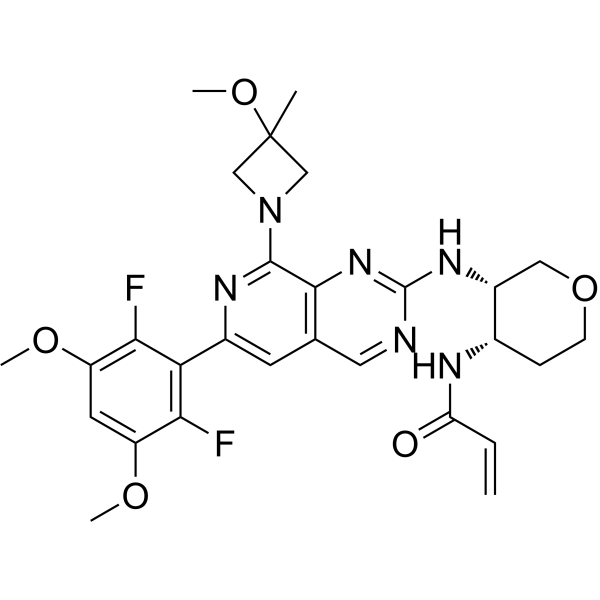
-
- HY-133669
-
|
|
Discoidin Domain Receptor
|
Cancer
|
|
DDR1-IN-5 is a selective Discoidin Domain Receptor family, member 1 (DDR1) inhibitor with an IC50 of 7.36 nM. DDR1-IN-5 inhibits auto-phosphorylation DDR1b (Y513) with an IC50 of 4.1 nM. DDR1-IN-5 has anti-cancer activity . DDR1-IN-5 is a click chemistry reagent, it contains an Alkyne group and can undergo copper-catalyzed azide-alkyne cycloaddition (CuAAc) with molecules containing Azide groups.
|
-

-
- HY-133670
-
|
|
Discoidin Domain Receptor
|
Cancer
|
|
DDR1-IN-6 is a selective Discoidin Domain Receptor family, member 1 (DDR1) inhibitor with an IC50 of 9.72 nM. DDR1-IN-6 inhibits auto-phosphorylation DDR1b (Y513) with an IC50 of 9.7 nM. DDR1-IN-6 has anti-cancer activity . DDR1-IN-6 is a click chemistry reagent, it contains an Alkyne group and can undergo copper-catalyzed azide-alkyne cycloaddition (CuAAc) with molecules containing Azide groups.
|
-
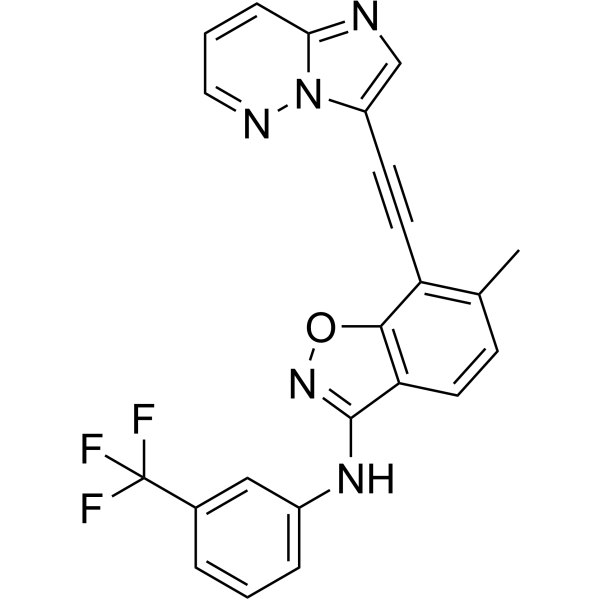
-
- HY-162309
-
|
|
c-Fms
|
Cancer
|
|
CSF1R-IN-20 (compound 7a) is a CSF-1R Inhibitor with an IC50 value of 467 nM. CSF1R-IN-20 inhibits CSF-1R auto-phosphorylation .
|
-
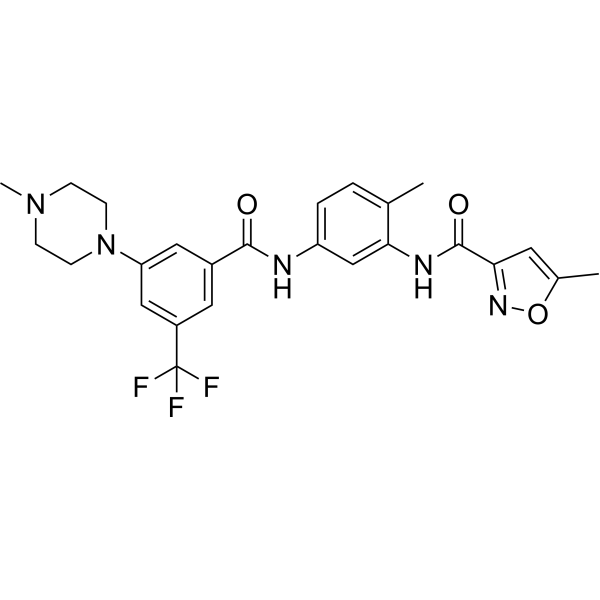
-
- HY-P2548
-
|
|
EGFR
|
Others
|
|
pp60 (v-SRC) Autophosphorylation Site, Phosphorylated is the phosphorylated peptide of an EGFR substrate. pp60 (v-SRC) Autophosphorylation Site, Phosphorylated can be used for the screening of EGFR Kinase inhibitors via phosphorylated-substrate quantification .
|
-

-
- HY-101521
-
|
|
Btk
|
Cancer
|
|
CHMFL-BTK-01 (compound 9) is a highly selective irreversible BTK inhibitor, with an IC50 of 7 nM. CHMFL-BTK-01 (compound 9) potently inhibited BTK Y223 auto-phosphorylation .
|
-

-
- HY-157996
-
|
|
c-Fms
|
Neurological Disease
|
|
CSF1R-IN-21 (compound 7e) is a CSF-1R Inhibitor with an IC50 value of 31 nM. CSF1R-IN-21 inhibits CSF-1R auto-phosphorylation and can be used for the research of neurodegenerative diseases .
|
-
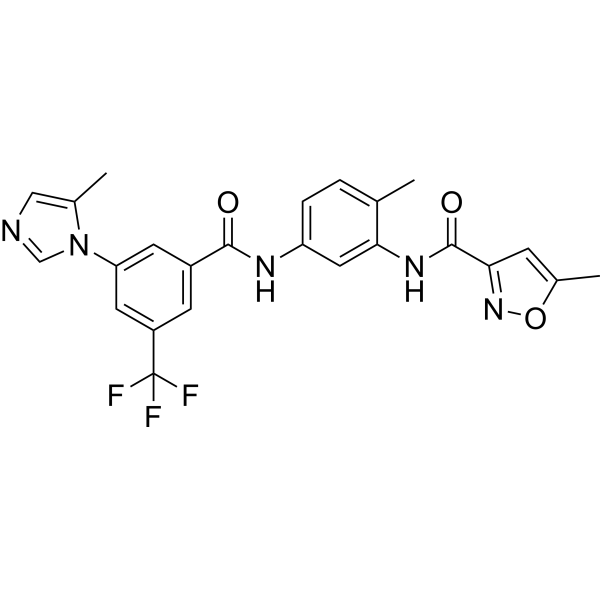
-
- HY-103248
-
|
Vengicide
|
IRE1
Fungal
Antibiotic
Apoptosis
CDK
|
Infection
Cancer
|
|
Toyocamycin (Vengicide) is an adenosine analog produced by Streptomyces diastatochromogenes, acts as an XBP1 inhibitor. Toyocamycin blocks RNA synthesis and ribosome function, and induces apoptosis. Toyocamycin affects IRE1α-XBP1 pathway, and inhibits XBP1 mRNA cleavage with an IC50 value of 80 nM with affecting IRE1α auto-phosphorylation. Toyocamycin specifically inhibits CDK9 with an IC50 value of 79 nM .
|
-
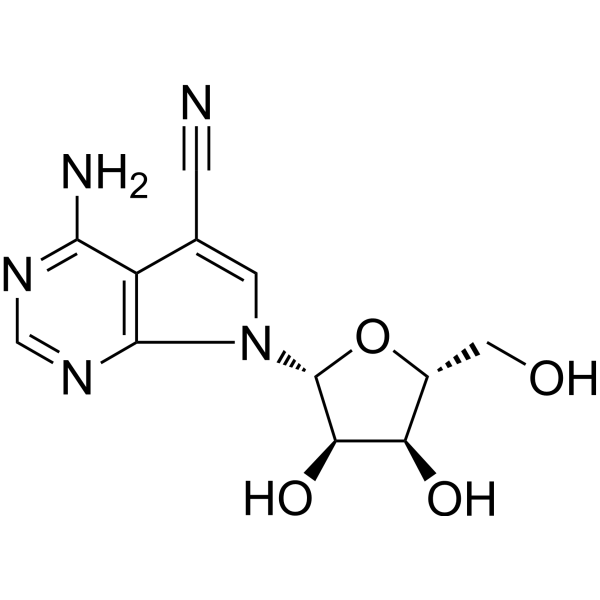
-
- HY-101957
-
AG 1295
2 Publications Verification
|
PDGFR
|
Cardiovascular Disease
|
|
AG 1295 is a selective platelet-derived growth factor receptor (PDGFR) tyrosine-kinase inhibitor. AG1295 abolishes autophosphorylation of the PDGFR whereas not affects the autophosphorylation of the EGF receptor .
|
-

-
- HY-107594
-
|
|
JAK
|
Cancer
|
|
Benzene hexabromide, a bromohydrocarbon, is a potent inhibitor of JAK2 tyrosine kinase autophosphorylation.
|
-
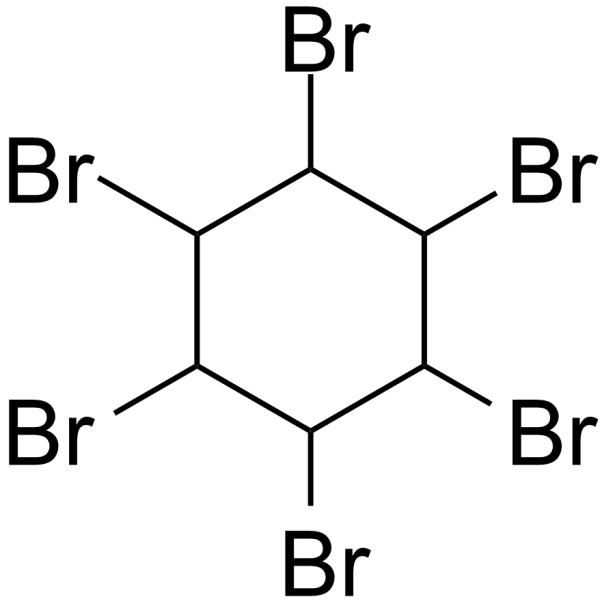
-
- HY-10255A
-
|
SU 11248
|
VEGFR
PDGFR
IRE1
Mitophagy
Autophagy
Apoptosis
|
Cancer
|
|
Sunitinib (SU 11248) is a multi-targeted receptor tyrosine kinase inhibitor with IC50s of 80 nM and 2 nM for VEGFR2 and PDGFRβ, respectively . Sunitinib, an ATP-competitive inhibitor, effectively inhibits autophosphorylation of Ire1α by inhibiting autophosphorylation and consequent RNase activation .
|
-
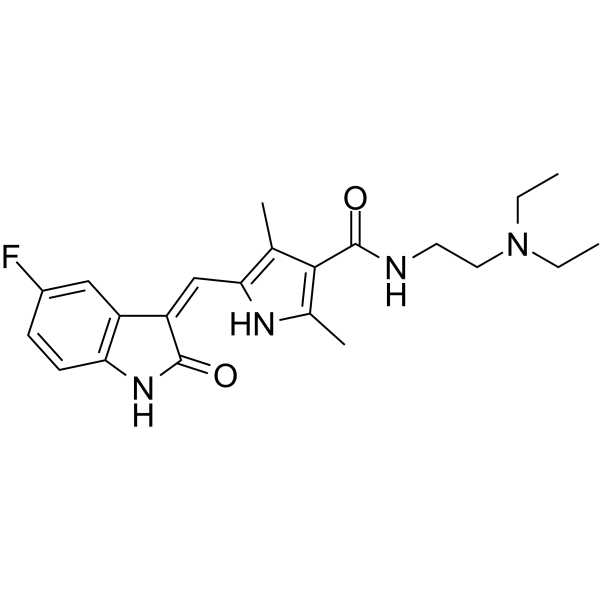
-
- HY-10255
-
|
SU 11248 Malate
|
PDGFR
VEGFR
IRE1
Mitophagy
Autophagy
Apoptosis
|
Cancer
|
|
Sunitinib Malate (SU 11248 Malate) is a multi-targeted receptor tyrosine kinase inhibitor with IC50s of 80 nM and 2 nM for VEGFR2 and PDGFRβ, respectively . Sunitinib Malate, an ATP-competitive inhibitor, effectively inhibits autophosphorylation of Ire1α by inhibiting autophosphorylation and consequent RNase activation .
|
-
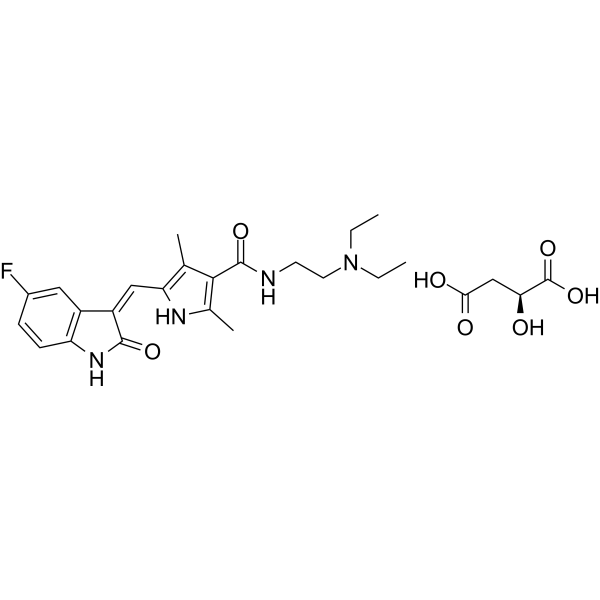
-
- HY-101429
-
|
Tyrphostin RG13022
|
EGFR
|
Cancer
|
|
RG13022 is a tyrosine kinase inhibitor; inhibits the autophosphorylation reaction of the EGF receptor with an IC50 of 4 μM.
|
-

-
- HY-145565
-
|
TPX-0046
|
RET
|
Cancer
|
|
Enbezotinib, an inhibitor of RET, can inhibit the RET autophosphorylation. Enbezotinib can be used for the research of cancer .
|
-
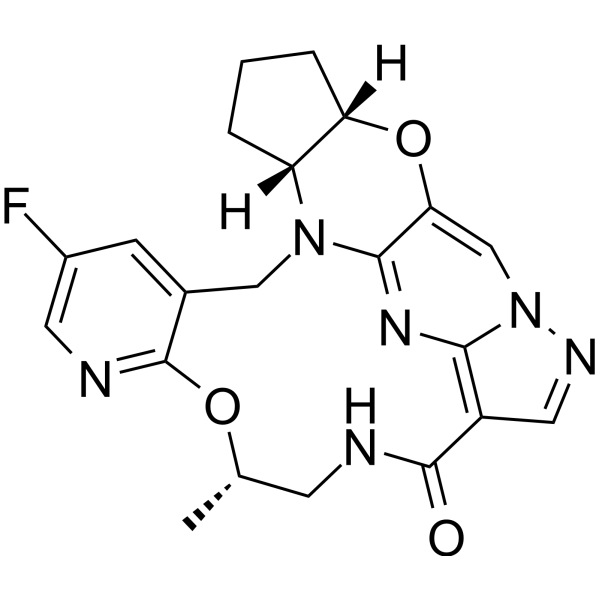
-
- HY-103471
-
|
|
FAK
|
Cancer
|
|
Y11 inhibits FAK1 autophosphorylation by blocking phosphorylation of Y397 and decreases tumor growth .
|
-
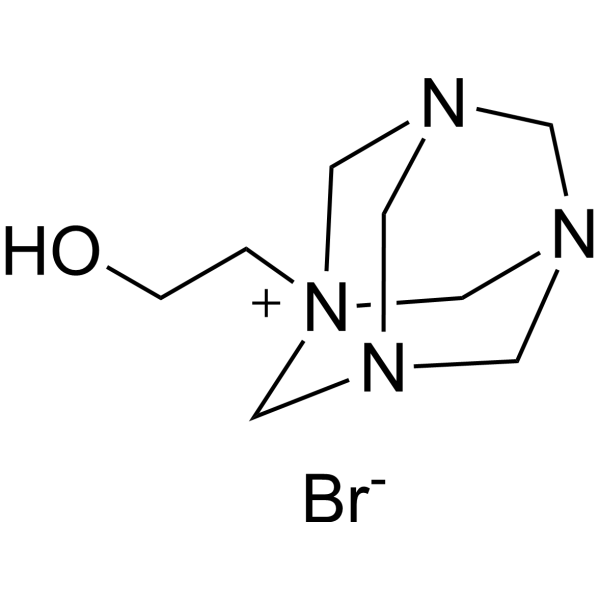
-
- HY-10255AS
-
|
SU 11248-d10
|
|
|
|
Sunitinib-d10 is a deuterium labeled Sunitinib. Sunitinib is a multi-targeted receptor tyrosine kinase inhibitor with IC50s of 80 nM and 2 nM for VEGFR2 and PDGFRβ, respectively[1]. Sunitinib, an ATP-competitive inhibitor, effectively inhibits autophosphorylation of Ire1α by inhibiting autophosphorylation and consequent RNase activation[2].
|
-
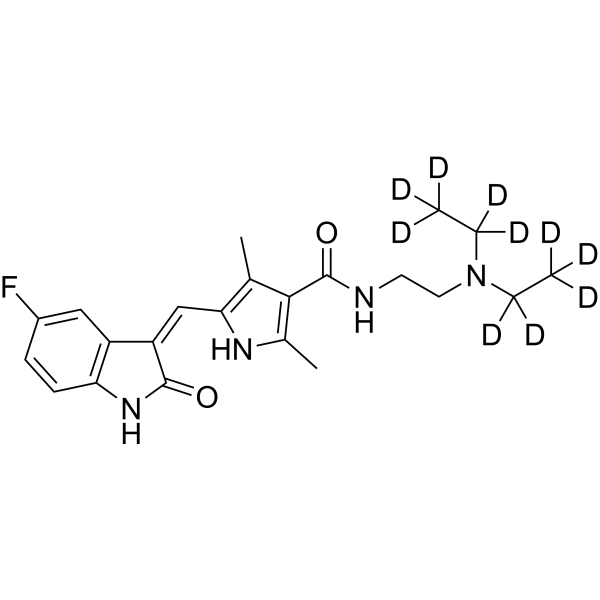
-
- HY-10255AS1
-
|
|
Isotope-Labeled Compounds
VEGFR
PDGFR
IRE1
Mitophagy
Autophagy
Apoptosis
|
Cancer
|
|
Sunitinib-d4 is the deuterium labeled Sunitinib. Sunitinib (SU 11248) is a multi-targeted receptor tyrosine kinase inhibitor with IC50s of 80 nM and 2 nM for VEGFR2 and PDGFRβ, respectively[1]. Sunitinib, an ATP-competitive inhibitor, effectively inhibits autophosphorylation of Ire1α by inhibiting autophosphorylation and consequent RNase activation[2].
|
-
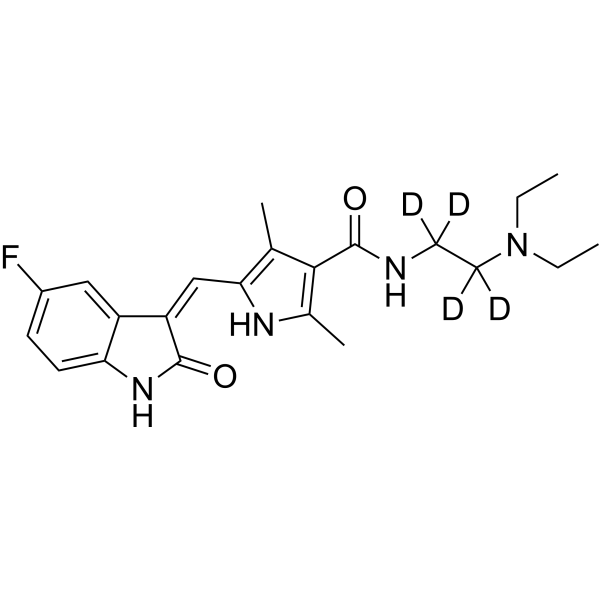
-
- HY-10327
-
|
|
TGF-β Receptor
|
Metabolic Disease
|
|
GW-6604 is an ALK5 inhibitor with an IC50 value of 140 nM for inhibiting its autophosphorylation, and can be used in the study of liver fibrosis .
|
-
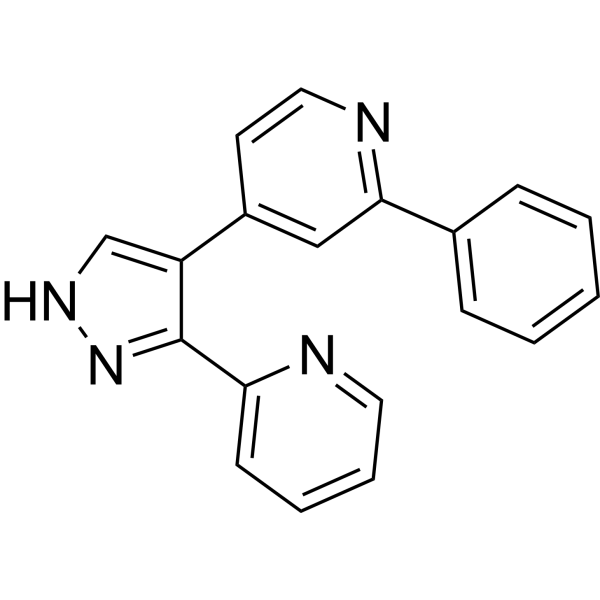
-
- HY-15002
-
AST 487
4 Publications Verification
NVP-AST 487
|
RET
FLT3
VEGFR
c-Kit
Bcr-Abl
|
Cancer
|
|
AST 487 is a RET kinase inhibitor with IC50 of 880 nM, inhibits RET autophosphorylation and activation of downstream effectors, also inhibits Flt-3 with IC50 of 520 nM.
|
-
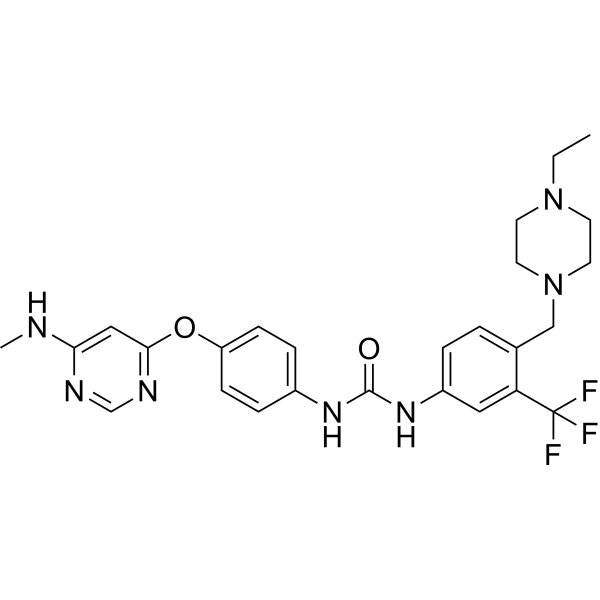
-
- HY-12444
-
|
FAK Inhibitor 14
|
FAK
|
Cancer
|
|
Y15 is a potent and specific inhibitor of focal adhesion kinase (FAK) that inhibits its autophosphorylation activity, decreases the viability of cancer cells, and blocks tumor growth.
|
-
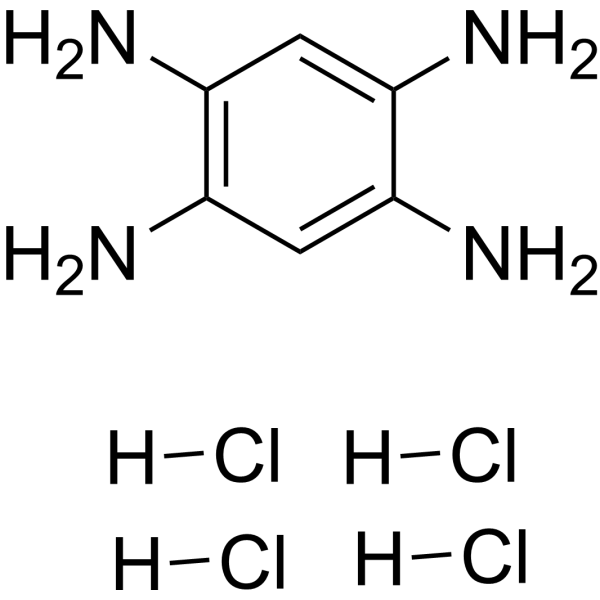
-
- HY-13258A
-
|
BHG712
|
Ephrin Receptor
|
Cancer
|
|
NVP-BHG712 is an oral active EphB4 kinase autophosphorylation inhibitor, with IC50 values of 3.3 nM and 3.0 nM for EphA2 and EphB4, respectively .
|
-
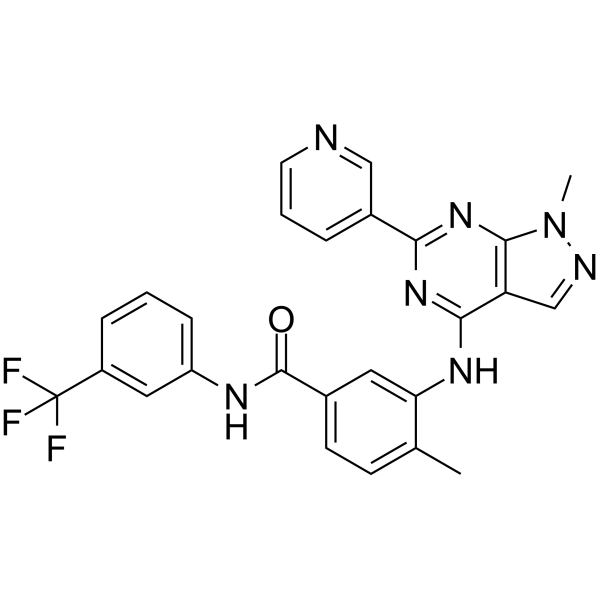
-
- HY-149413
-
|
|
RET
|
Others
|
|
FHND5071 is a potent and selective RET kinase inhibitor, FHND5071 can exert antitumor effects by inhibiting RET autophosphorylation. FHND5071 can be used for tumor diseases research .
|
-
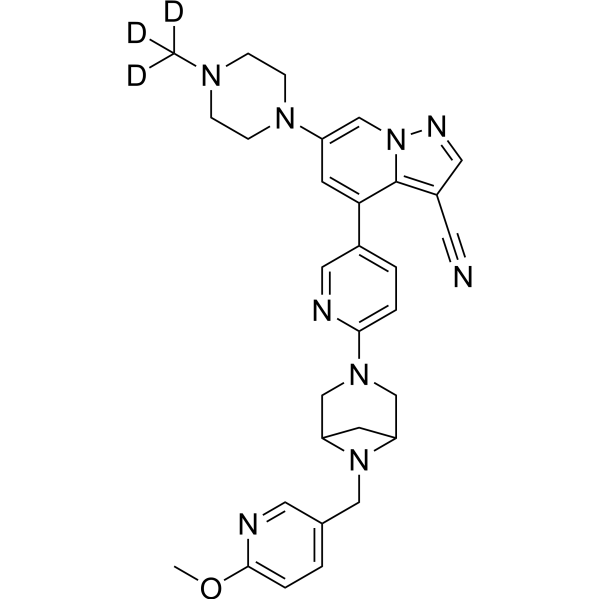
-
- HY-103443
-
|
|
EGFR
|
Cancer
|
|
HKI-357 is an irreversible dual inhibitor of EGFR and ERBB2 with IC50s of 34 nM and 33 nM, respectively. HKI-357 suppresses EGFR autophosphorylation (at Y1068), and AKT and MAPK phosphorylation .
|
-
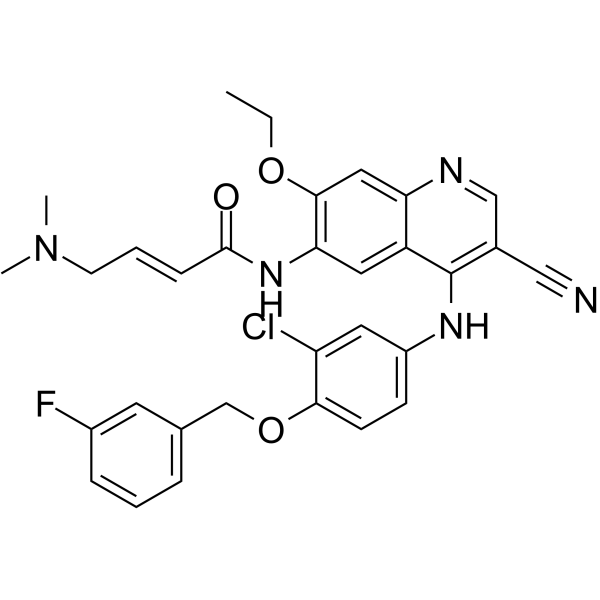
-
- HY-144131
-
|
|
Apoptosis
RET
|
Cancer
|
|
RET-IN-11 is a potent and selective RET inhibitor with IC50s of 6.20 nM, 18.68 nM for RET and RET V804M, respectively. RET-IN-11 shows anti-proliferation and migration activity in CCDC6-RET-driven LC-2/ad cells. RET-IN-11 induces cell apoptosis .
|
-
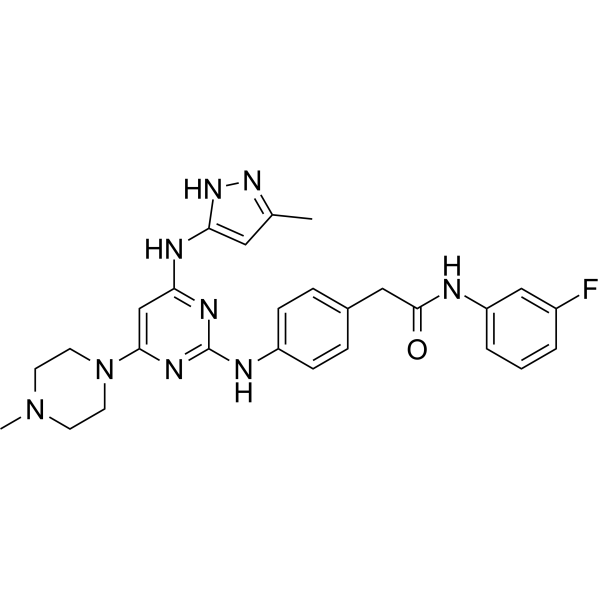
-
- HY-114173
-
-

-
- HY-101962
-
|
|
Insulin Receptor
|
Metabolic Disease
|
|
HNMPA is a membrane impermeable insulin receptor tyrosine kinase inhibitor. HNMPA inhibits serine and tyrosine autophosphorylation by the human insulin receptor. HNMPA has no effect on protein kinase C or cyclic AMP-dependent protein kinase activities
|
-

-
- HY-18899
-
|
|
|
|
|
Nec-3a is a Necrostatin-3 analogue. Nec-3a is a RIP1 inhibitor (IC50: 0.44 μM). Nec-3a inhibits the autophosphorylation activity of the RIP1 kinase domain .
|
-
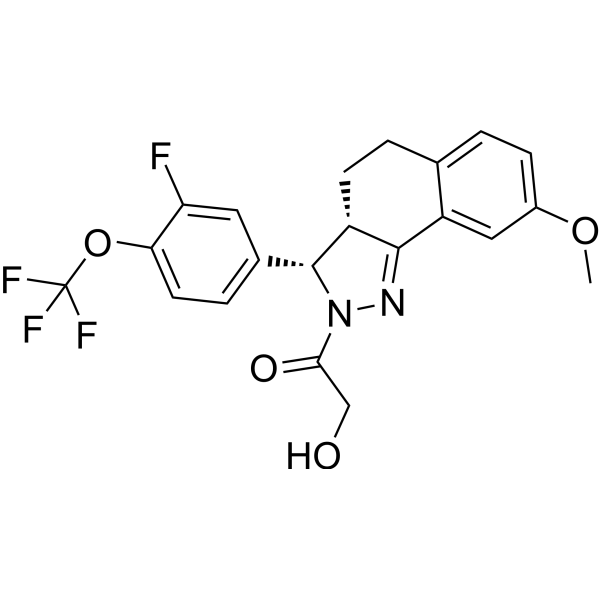
-
- HY-10367A
-
|
CI-1033 dihydrochloride; PD-183805 dihydrochloride
|
EGFR
Orthopoxvirus
|
Infection
Cancer
|
|
Canertinib dihydrochloride (CI-1033 dihydrochloride) is a potent and irreversible EGFR inhibitor; inhibits cellular EGFR and ErbB2 autophosphorylation with IC50s of 7.4 and 9 nM. Canertinib dihydrochloride is active against vaccinia virus respiratory infection in mice .
|
-
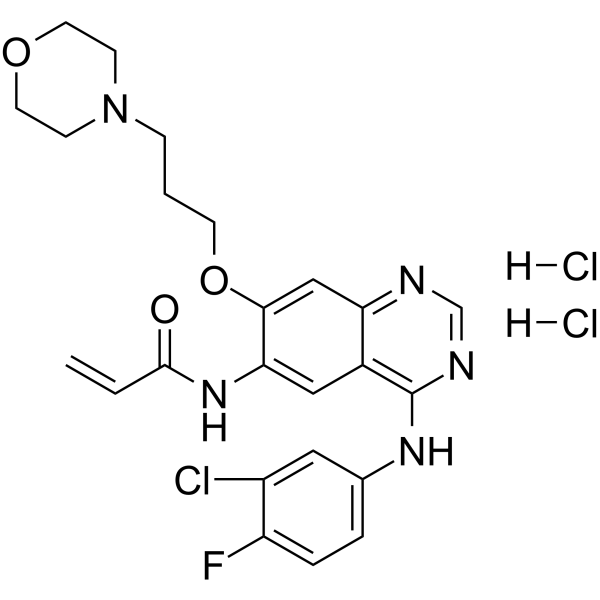
-
- HY-125203
-
|
NSC 744039
|
Checkpoint Kinase (Chk)
|
Cancer
|
|
PV-1019 (NSC 744039) is a potent, selective Chk2 inhibitor with an IC50 value of 24 nM. PV-1019 inhibits the Topotecan (HY-13768)-induced Chk2 autophosphorylation. PV-1019 inhibits IR-induced apoptosis .
|
-

-
- HY-17537
-
|
|
IRE1
|
Cancer
|
|
APY29, an ATP-competitive inhibitor, is an allosteric modulator of IRE1α which inhibits IRE1α autophosphorylation by binding to the ATP-binding pocket with IC50 of 280 nM. APY29 acts as a ligand that allosterically activates IRE1α adjacent RNase domain .
|
-

-
- HY-15841
-
|
|
Anaplastic lymphoma kinase (ALK)
FAK
|
Cancer
|
|
CEP-37440 is a potent, orally active dual FAK/ALK inhibitor with IC50 values of 2.3 nM and 3.5 nM for FAK and ALK, respectively. CEP-37440 decreases the cell proliferation by blocking the autophosphorylation kinase activity of FAK1 (Tyr 397) .
|
-
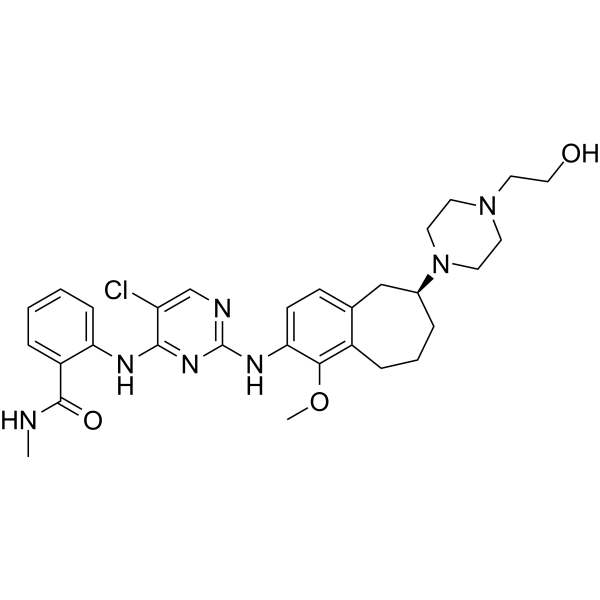
-
- HY-P1799
-
|
|
Phosphatase
|
Others
|
|
[pTyr5] EGFR (988-993) is derived from the autophosphorylation site (Tyr992) of epidermal growth factor receptor (EGFR 988-993). [pTyr5] EGFR (988-993) is often complexed with the catalytically inactive protein-tyrosine phosphate 1B (PTP1B) .
|
-
![[pTyr5] EGFR (988-993)](//file.medchemexpress.com/product_pic/hy-p1799.gif)
-
- HY-144448
-
|
|
FAK
Apoptosis
|
Cancer
|
|
FAK-IN-2 is a potent and orally active focal adhesion kinase (FAK) inhibitor, with anticancer activity (FAK IC50= 35 nM). FAK-IN-2 covalently inhibits the autophosphorylation of FAK in a dose-dependent manner, and inhibits the clone formation and migration of tumor cells, inducing apoptosis .
|
-
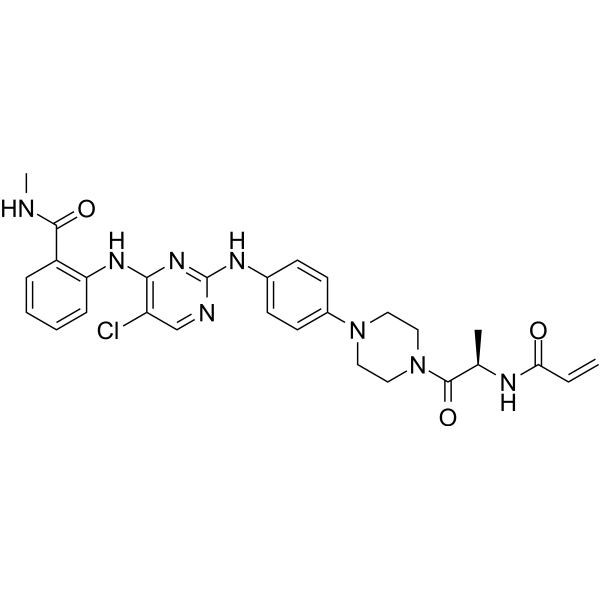
-
- HY-119910
-
|
XIB4035
|
GDNF Receptor
|
Neurological Disease
|
|
(E)-Aminoquinol (XIB4035) is a GFRα-1 agonist. (E)-Aminoquinol has mimic neurotrophic effects of GDNF, and induces Ret autophosphorylation in Neuro-2A cells. (E)-Aminoquinol can be used for research of Parkinson’s disease .
|
-
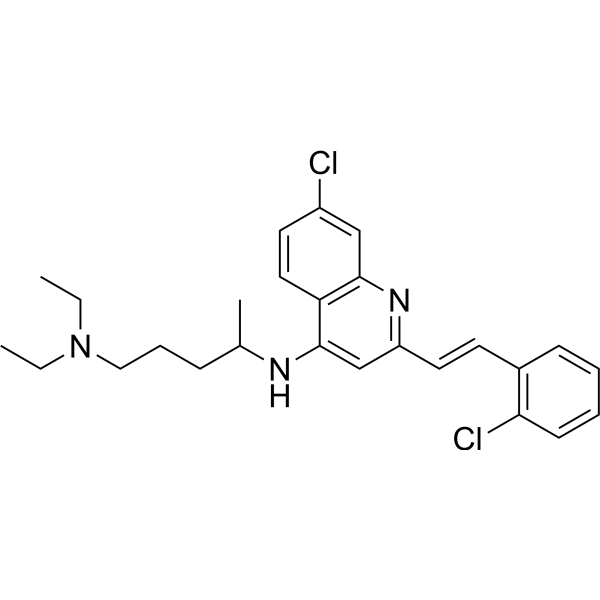
-
- HY-15480
-
|
JAK2 Inhibitor V; Z3
|
JAK
|
Cancer
|
|
NSC 42834 (JAK2 Inhibitor V), a novel specific inhibitor of Jak2, inhibits Jak2-V617F and Jak2-WT autophosphorylation in a dose-dependent manner but was not cytotoxic to cells at concentrations that inhibited kinase activity.
|
-
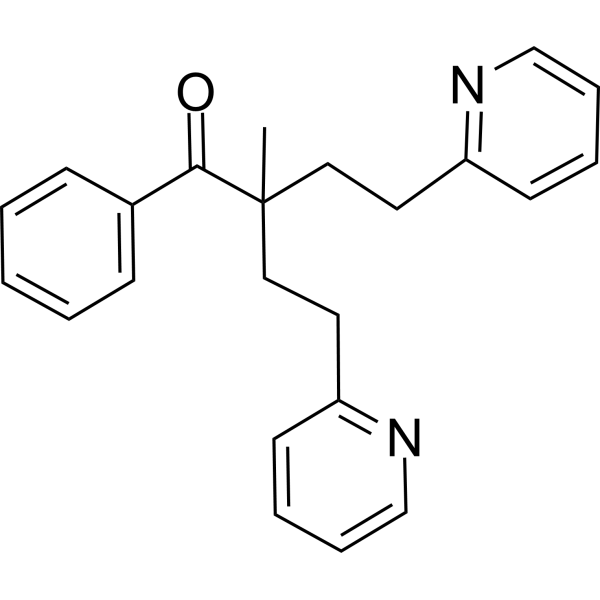
-
- HY-10367
-
|
CI-1033; PD-183805
|
EGFR
Orthopoxvirus
|
Infection
Cancer
|
|
Canertinib (CI-1033;PD-183805) is a potent and irreversible EGFR inhibitor; inhibits cellular EGFR and ErbB2 autophosphorylation with IC50s of 7.4 and 9 nM. Canertinib is active against vaccinia virus respiratory infection in mice .
|
-

-
- HY-P1799A
-
|
|
Phosphatase
|
Others
|
|
[pTyr5] EGFR (988-993) TFA is derived from the autophosphorylation site (Tyr992) of epidermal growth factor receptor (EGFR 988-993). [pTyr5] EGFR (988-993) TFA is often complexed with the catalytically inactive protein-tyrosine phosphate 1B (PTP1B) .
|
-
![[pTyr5] EGFR (988-993) (TFA)](//file.medchemexpress.com/product_pic/hy-p1799a.gif)
-
- HY-12282
-
|
|
LRRK2
|
Neurological Disease
|
|
GNE-9605 is a potent, orally active, selective Leucine-rich repeat kinase 2 (LRRK2) inhibitor with an IC50 value of 18.7 nM. GNE-9605 inhibits LRRK2 Ser1292 autophosphorylation. GNE-9605 can be used in research of Parkinson's disease (PD) .
|
-
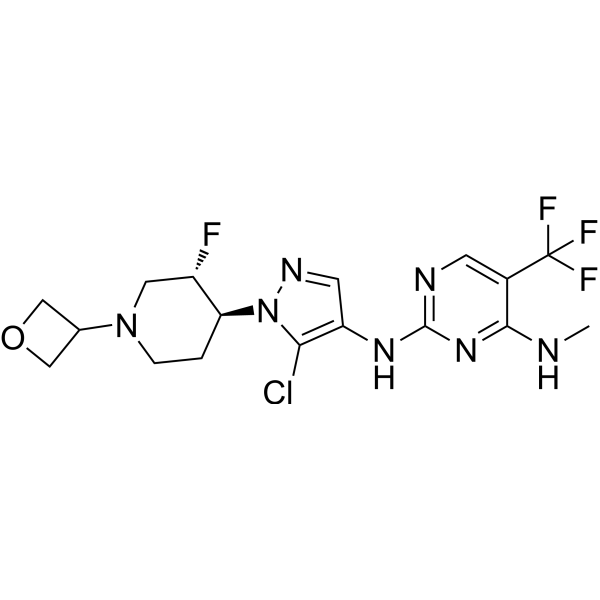
-
- HY-112198
-
|
|
ATM/ATR
|
Cancer
|
|
AZ31 is a a potent, highly selective, and orally active ATM inhibitor with an IC50 of <1.2 nM for ATM enzyme, and an IC50 of 46 nM for ATM in cell. AZ31 shows excellent selectivity over ATR (>500-fold) and excellent PIKK-family selectivity and pan-kinase selectivity. AZ31 is a potent radiosensitizer in vitro, it can be used for the research of cancer .
|
-
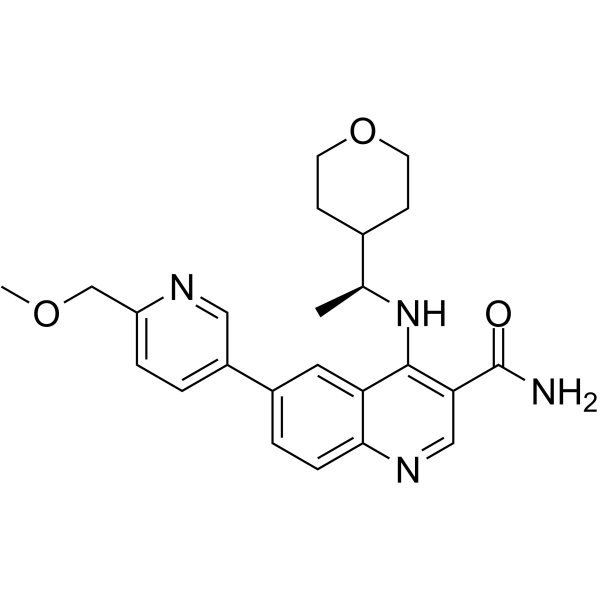
-
- HY-50895A
-
|
ZD-1839 hydrochloride
|
EGFR
|
Cancer
|
|
Gefitinib hydrochloride (ZD1839 hydrochloride) is a potent, selective and orally active EGFR tyrosine kinase inhibitor with an IC50 of 33 nM. Gefitinib hydrochloride selectively inhibits EGF-stimulated tumor cell growth (IC50 of 54 nM) and that blocks EGF-stimulated EGFR autophosphorylation in tumor cells. Gefitinib hydrochloride also induces autophagy. Gefitinib hydrochloride has antitumour activity .
|
-

-
- HY-152183
-
|
|
DYRK
|
Neurological Disease
|
|
FINDY is a folding intermediate-selective inhibitor of DYRK1A. FINDY can inhibit Ser97 autophosphorylation with an IC50 value of 35 μM. FINDY can be used for the research of neurological disorder . FINDY is a click chemistry reagent, it contains an Alkyne group and can undergo copper-catalyzed azide-alkyne cycloaddition (CuAAc) with molecules containing Azide groups.
|
-
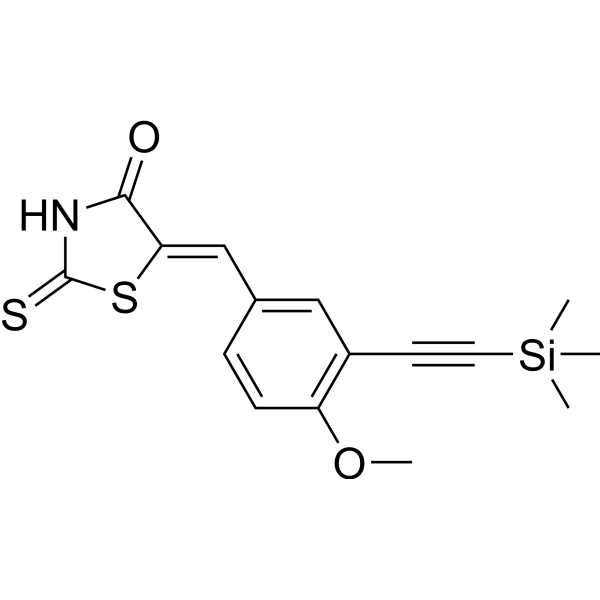
-
- HY-14674
-
|
|
EGFR
Apoptosis
|
Cancer
|
|
CP-724714 is a potent, selective and orally active ErbB2 (HER2) tyrosine kinase inhibitor, with an IC50 of 10 nM. CP-724714 displays a marked selectivity against EGFR kinase (IC50=6400 nM). CP-724714 potently inhibits ErbB2 receptor autophosphorylation in intact cells. Antitumor activities .
|
-
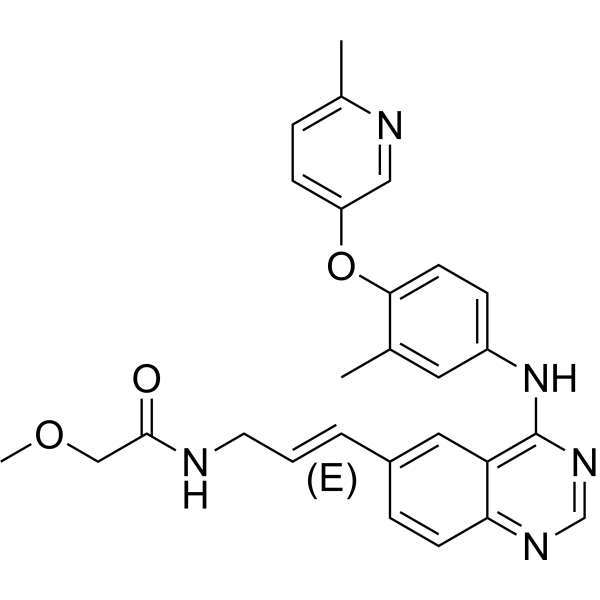
-
- HY-13012
-
|
E-616452; SJN 2511
|
Organoid
TGF-β Receptor
|
Metabolic Disease
|
|
RepSox (E-616452) is a potent and selective transforming growth factor-beta receptor I/activin like kinase 5 (TGF-β-RI/ALK5) inhibitor. RepSox inhibits ALK5 autophosphorylation with an IC50 value of 4 nM. RepSox can be used for the research of obesity and associated metabolic diseases such as type 2 diabetes .
|
-
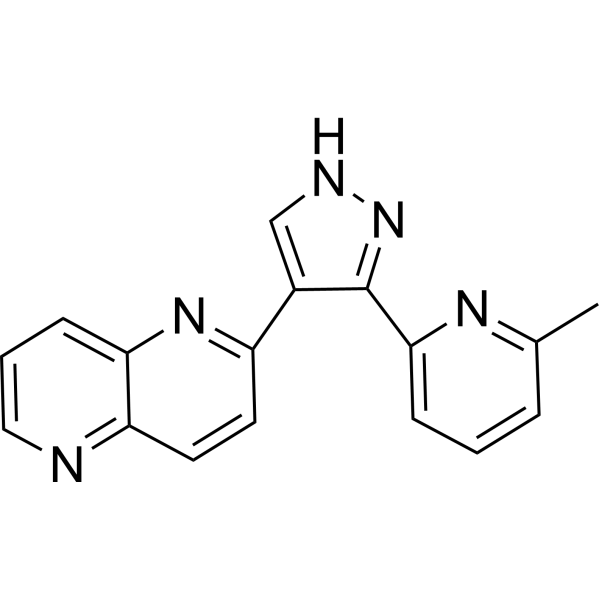
-
- HY-108263
-
|
CGP52421
|
FLT3
|
Cancer
|
|
3-Hydroxy Midostaurin (CGP 52421), a metabolite of PKC412, effectively inhibits FMS-like tyrosine kinase-3 (FLT3) autophosphorylation with IC50s of approximately 132 nM and 9.8 μM in culture medium and plasma, respectively. 3-Hydroxy Midostaurin is less selective but more cytotoxic than PKC412 .
|
-
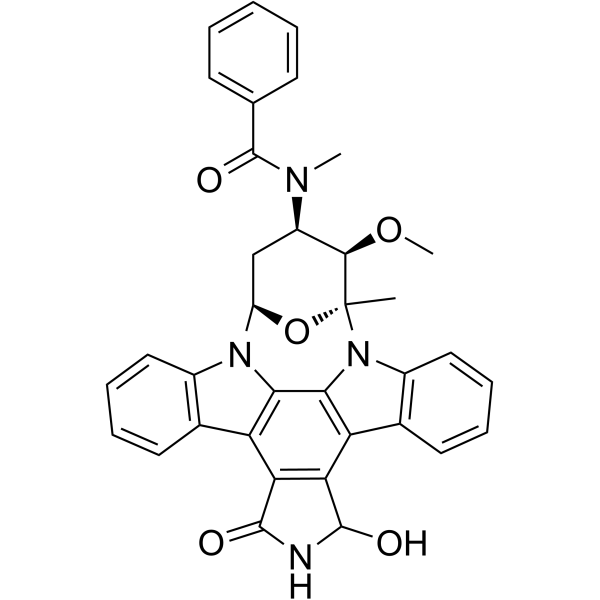
-
- HY-131257
-
|
|
Drug Metabolite
|
Others
|
|
Gefitinib impurity 1 is the impurity of Gefitinib. Gefitinib (ZD1839) is a potent, selective and orally active EGFR tyrosine kinase inhibitor with an IC50 of 33 nM. Gefitinib selectively inhibits EGF-stimulated tumor cell growth (IC50 of 54 nM) and that blocks EGF-stimulated EGFR autophosphorylation in tumor cells. Gefitinib also induces autophagy. Gefitinib has antitumour activity .
|
-
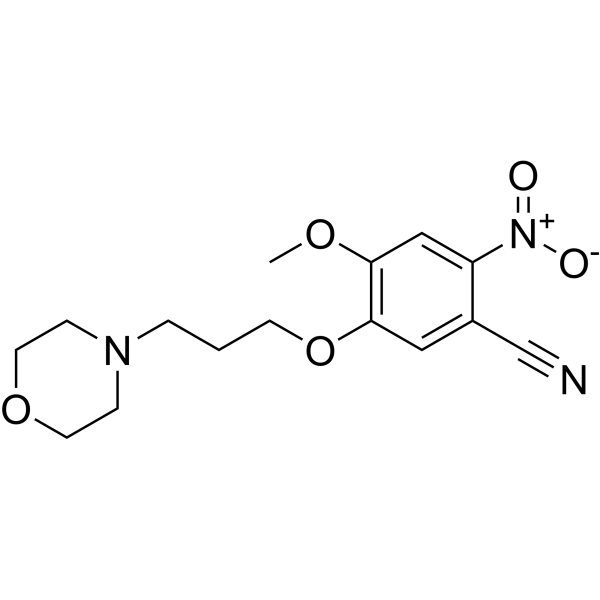
-
- HY-133779
-
|
|
Drug Metabolite
|
Others
|
|
Gefitinib impurity 5 is the impurity of Gefitinib. Gefitinib (ZD1839) is a potent, selective and orally active EGFR tyrosine kinase inhibitor with an IC50 of 33 nM. Gefitinib selectively inhibits EGF-stimulated tumor cell growth (IC50 of 54 nM) and that blocks EGF-stimulated EGFR autophosphorylation in tumor cells. Gefitinib also induces autophagy. Gefitinib has antitumour activity .
|
-
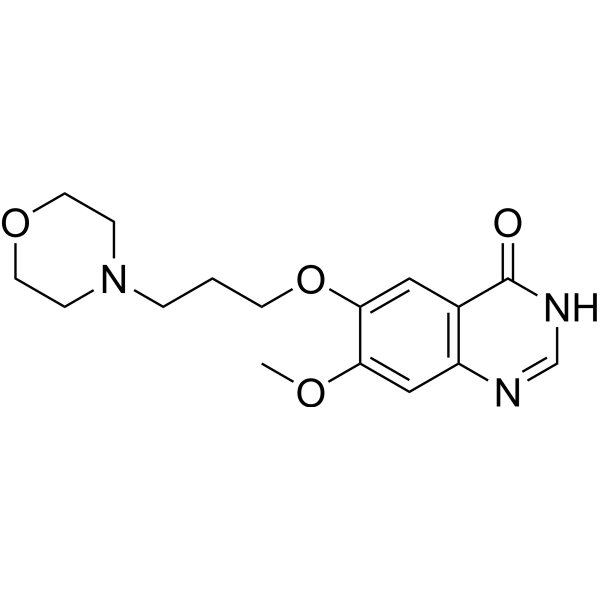
-
- HY-136895
-
|
|
Prostaglandin Receptor
|
Cancer
|
|
AZ12672857 is an orally active inhibitor of EphB4 (IC50=1.3 nM) and Src kinases. AZ12672857 shows good inhibition of proliferation of c-Src transfected 3T3 cells (IC50=2 nM) as well as autophosphorylation of EphB4 in transfected CHO-K1 cells (IC50=9 nM) .
|
-

-
- HY-108263S
-
|
CGP52421-d5
|
Isotope-Labeled Compounds
FLT3
|
Cancer
|
|
3-Hydroxy Midostaurin-d5 is a deuterium labeled 3-Hydroxy Midostaurin. 3-Hydroxy Midostaurin is a metabolite of PKC412, which effectively inhibits FMS-like tyrosine kinase-3 (FLT3) autophosphorylation with IC50s of approximately 132 nM and 9.8 μM in culture medium and plasma, respectively[1].
|
-

-
- HY-50895
-
Gefitinib
Maximum Cited Publications
112 Publications Verification
ZD1839
|
EGFR
Autophagy
Apoptosis
|
Cancer
|
|
Gefitinib (ZD1839) is a potent, selective and orally active EGFR tyrosine kinase inhibitor with an IC50 of 33 nM. Gefitinib selectively inhibits EGF-stimulated tumor cell growth (IC50 of 54 nM) and that blocks EGF-stimulated EGFR autophosphorylation in tumor cells. Gefitinib also induces autophagy and cell apoptosis, which can be used for cancer related research, such as Lung cancer and breast cancer .
|
-
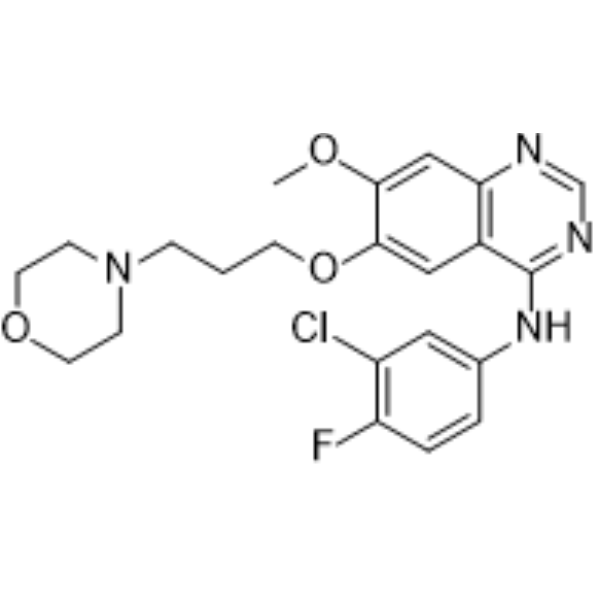
-
- HY-13905
-
|
HHGV678 mesylate
|
Bcr-Abl
c-Kit
PDGFR
|
Cancer
|
|
Flumatinib (HHGV678) mesylate is an orally active and selective inhibitor of Bcr-Abl. Flumatinib mesylate inhibits c-Abl, PDGFRβ and c-Kit with IC50 values of 1.2, 307.6 and 665.5 nM, respectively. Flumatinib mesylate inhibits Bcr-Abl autophosphorylation and Stat5 and Erk1/2 phosphorylation. Flumatinib mesylate inhibits tumor growth in chronic myelogenous leukemia model .
|
-
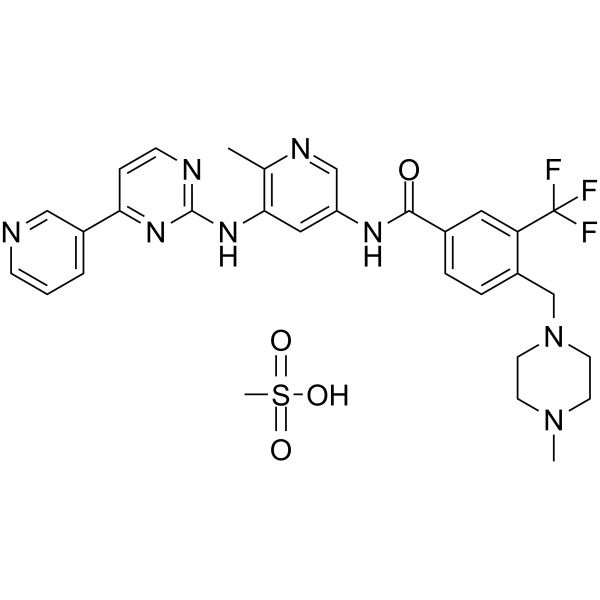
- HY-18509
-
|
|
IRE1
|
Cancer
|
|
IRE1α kinase-IN-2 is a potent IRE1α kinase inhibitor, with an EC50 of 0.82 μM. IRE1α kinase-IN-2 inhibits IRE1α kinase autophosphorylation (IC50=3.12 μM). IRE1α kinase-IN-2 inhibits XBP1 mRNA splicing in the WT cell lines .
|
-
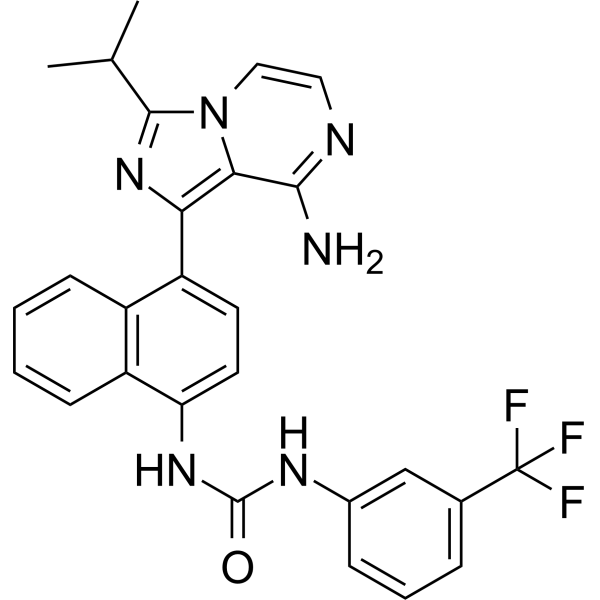
- HY-W062835
-
|
|
Src
|
Cancer
|
|
CGP77675 is an orally active and potent inhibitor of Src family kinases. CGP77675 inhibits phosphorylation of peptide substrates and autophosphorylation of purified Src (IC50s of 5-20 and 40 nM, respectively), and also inhibits Src, EGFR, KDR, v-Abl, and Lck with IC50s of 5-20, 40, 20, 150, 1000, 310, and 290 nM, respectively. Anticancer activity .
|
-

- HY-100663
-
|
|
EGFR
|
Others
|
|
Gefitinib impurity 2 is the impurity of Gefitinib. Gefitinib (ZD1839; HY-50895) is a potent, selective and orally active EGFR tyrosine kinase inhibitor with an IC50 of 33 nM. Gefitinib selectively inhibits EGF-stimulated tumor cell growth (IC50 of 54 nM) and that blocks EGF-stimulated EGFR autophosphorylation in tumor cells. Gefitinib also induces autophagy. Gefitinib has antitumour activity .
|
-
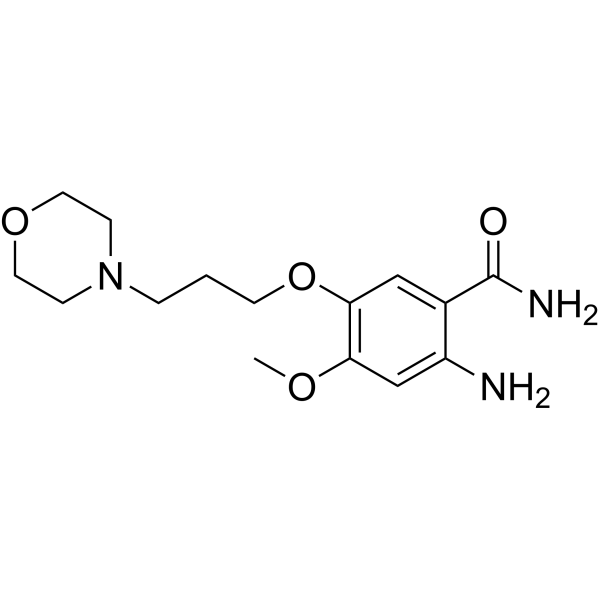
- HY-50895S1
-
|
ZD1839-d6
|
EGFR
Autophagy
|
Cancer
|
|
Gefitinib-d6 is the deuterium labeled Gefitinib. Gefitinib (ZD1839) is a potent, selective and orally active EGFR tyrosine kinase inhibitor with an IC50 of 33 nM. Gefitinib selectively inhibits EGF-stimulated tumor cell growth (IC50 of 54 nM) and that blocks EGF-stimulated EGFR autophosphorylation in tumor cells. Gefitinib also induces autophagy. Gefitinib has antitumour activity[1][2].
|
-

- HY-145652
-
|
AMP-945
|
FAK
|
Cancer
|
|
Narmafotinib (AMP-945) is an inhibitor of the enzyme focal adhesion kinase (FAK, KD=0.21 nM). Narmafotinib inhibits autophosphorylation of 397Y-FAK in MDA-MB-231 cells with an IC50=7 nM and exhibits low general cellular toxicity (IC50=2.7 μM, MDA-MB-231 cells) .
|
-
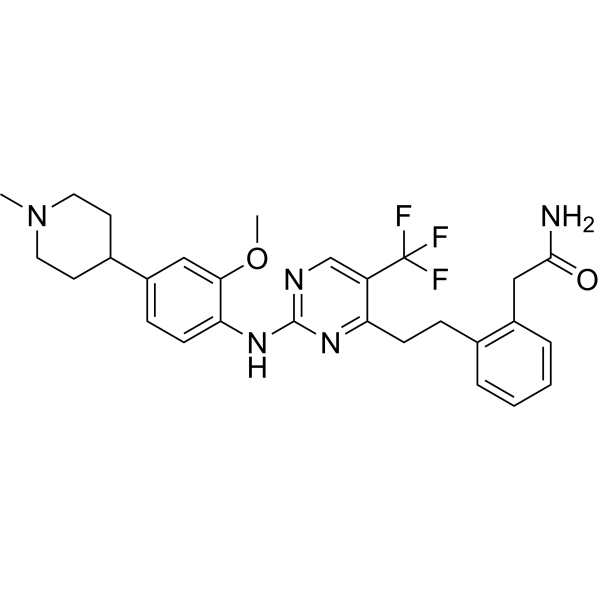
- HY-50895B
-
|
ZD 1839 dihydrochloride
|
|
|
|
Gefitinib (ZD 1839) dihydrochloride is a potent, selective and orally active EGFR tyrosine kinase inhibitor with an IC50 of 33 nM. Gefitinib dihydrochloride selectively inhibits EGF-stimulated tumor cell growth (IC50 of 54 nM) and blocks EGF-stimulated EGFR autophosphorylation in tumor cells. Gefitinib dihydrochloride also induces autophagy and cell apoptosis, which can be used for cancer related research, such as Lung cancer and breast cancer .
|
-
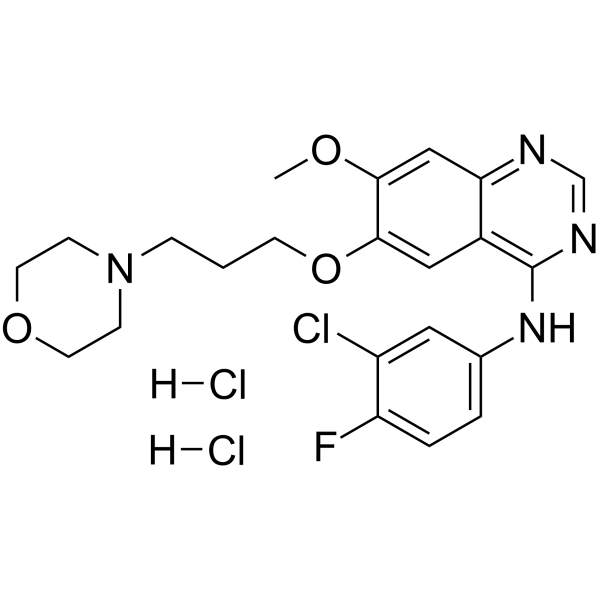
- HY-149517
-
|
|
EGFR
|
Cancer
|
|
E07 aptamer is an aptamer that targets human epidermal growth factor receptor (hEGFR). E07 aptamer can compete with EGF for binding, binds to a novel epitope on EGFR. E07 aptamer binds to cells expressing EGFR, blocks receptor autophosphorylation, and prevents proliferation of tumor cells in three-dimensional matrices. E07 aptamer can be used for tomor disease research .
|
-
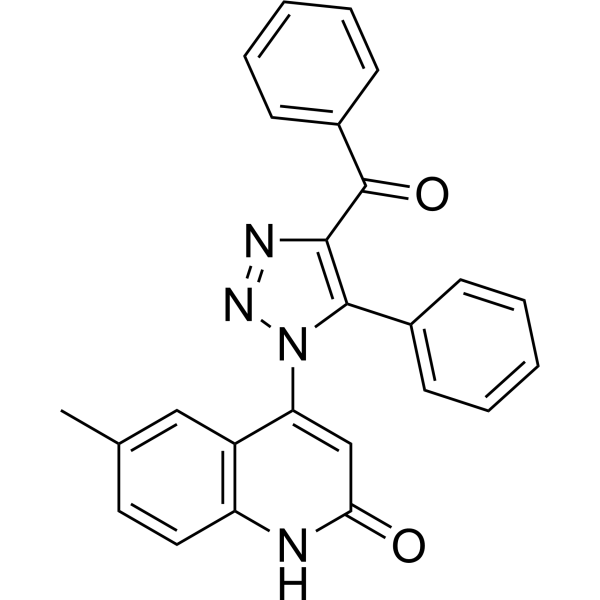
- HY-50896
-
|
CP-358774; NSC 718781; OSI-774
|
EGFR
Autophagy
|
Cancer
|
|
Erlotinib (CP-358774) is a directly acting EGFR tyrosine kinase inhibitor, with an IC50 of 2 nM for human EGFR. Erlotinib reduces EGFR autophosphorylation in intact tumor cells with an IC50 of 20 nM. Erlotinib is used for the treatment of non-small cell lung cancer . Erlotinib is a click chemistry reagent, itcontains an Alkyne group and can undergo copper-catalyzed azide-alkyne cycloaddition (CuAAc) with molecules containing Azide groups.
|
-
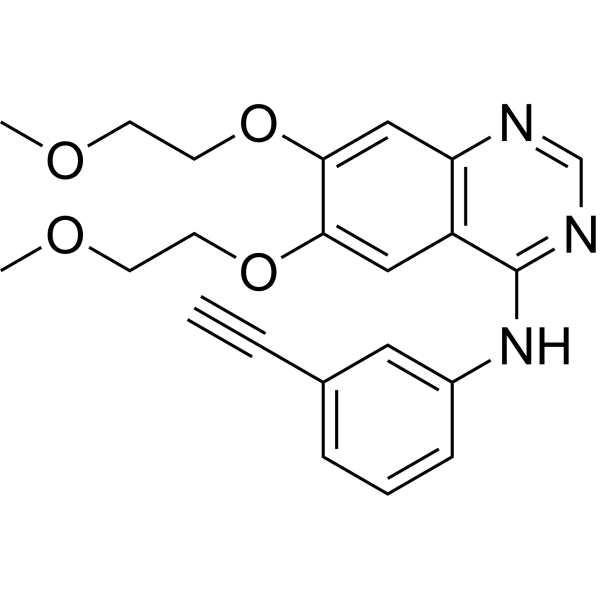
- HY-103274
-
|
|
Bcr-Abl
Src
c-Kit
Apoptosis
|
Neurological Disease
Cancer
|
|
PD180970 is a highly potent and ATP-competitive p210 Bcr-Abl kinase inhibitor, with an IC50 of 5 nM for inhibiting the autophosphorylation of p210 Bcr-Abl. PD180970 also inhibits Src and KIT kinase with IC50s of 0.8 nM and 50 nM, respectively. PD180970 indcues apoptosis of K562 leukemic cells, and can be used for chronic myelogenous leukemia research .
|
-
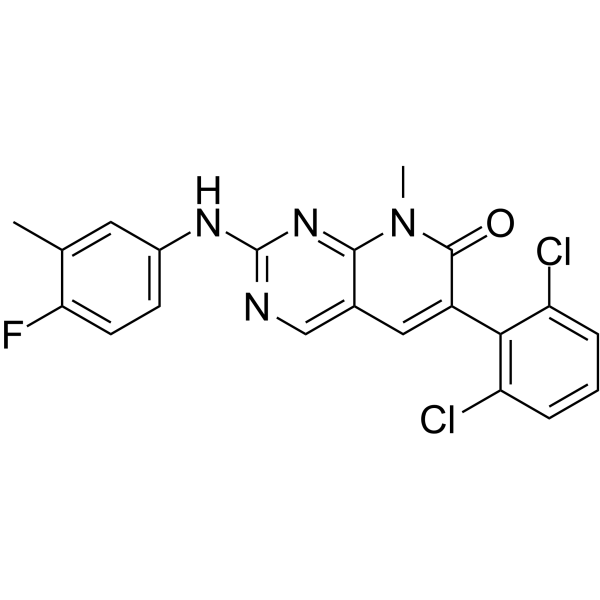
- HY-W062835A
-
|
|
Src
|
Cancer
|
|
CGP77675 hydrate is an orally active and potent inhibitor of Src family kinases. CGP77675 hydrate inhibits phosphorylation of peptide substrates and autophosphorylation of purified Src (IC50s of 5-20 and 40 nM, respectively),and also inhibits Src, EGFR, KDR, v-Abl, and Lck with IC50s of 0.02, 0.15, 1.0, 0.31, and 0.29 μM, respectively. Anticancer activity .
|
-
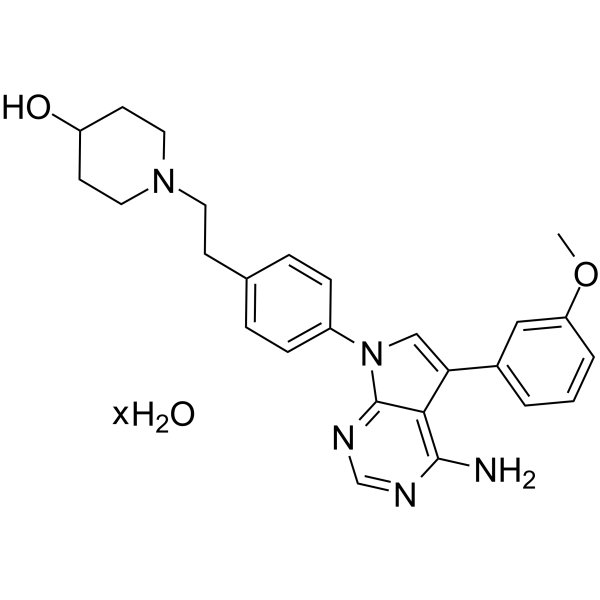
- HY-122727
-
|
|
DNA-PK
Apoptosis
|
Cancer
|
|
STL127705 (Compound L) is a potent Ku 70/80 heterodimer protein inhibitor with an IC50 of 3.5 μM. STL127705 interferes the binding of Ku70/80 to DNA and by inhibits the activation of the DNA-PKCS kinase. STL127705 shows antiproliferative and anticancer activity. STL127705 induces apoptosis .
|
-
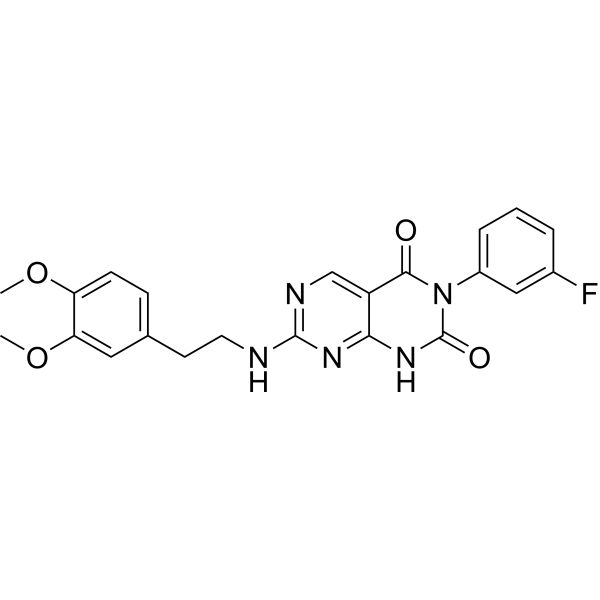
- HY-50895S2
-
|
|
Isotope-Labeled Compounds
EGFR
Autophagy
|
Cancer
|
|
Gefitinib-d3 (ZD1839-d3) is the deuterium labeled Gefitinib. Gefitinib (ZD1839) is a potent, selective and orally active EGFR tyrosine kinase inhibitor with an IC50 of 33 nM. Gefitinib selectively inhibits EGF-stimulated tumor cell growth (IC50 of 54 nM) and that blocks EGF-stimulated EGFR autophosphorylation in tumor cells. Gefitinib also induces autophagy. Gefitinib has antitumour activity[1][2].
|
-

- HY-13686
-
PQ401
2 Publications Verification
|
IGF-1R
Apoptosis
|
Cancer
|
|
PQ401 is a potent inhibitor of IGF-IR signaling. PQ401 inhibits IGF-I-stimulated IGF-IR autophosphorylation with an IC50 of 12.0 μM in a series of studies in MCF-7 cells. PQ401 is effective at inhibiting IGF-I-stimulated growth of MCF-7 cells (IC50, 6 μM). PQ401 is a potential agent for breast and other IGF-I-sensitive cancers. PQ401 induces caspase-mediated apoptosis .
|
-
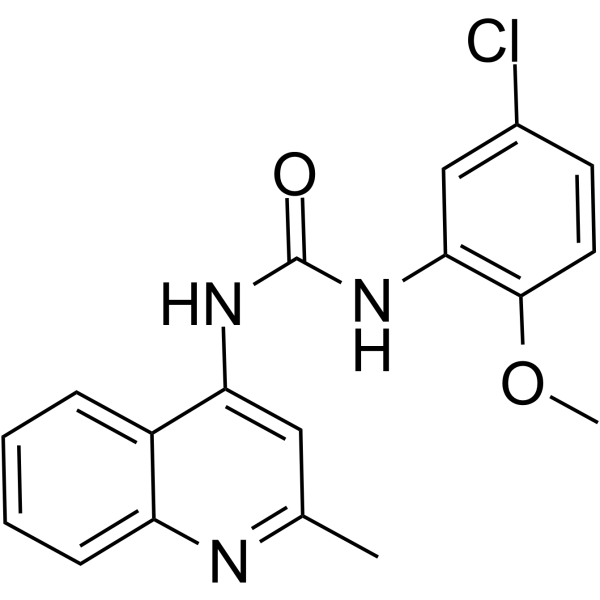
- HY-108485
-
|
|
Src
Apoptosis
Fungal
|
Infection
Inflammation/Immunology
Cancer
|
|
Damnacanthal is an anthraquinone isolated from the root of Morinda citrifolia. Damnacanthal is a highly potent, selective inhibitor of p56 lck tyrosine kinase activity. Natural Damnacanthal inhibits p56 lck autophosphorylation and phosphorylation of exogenous substrates with IC50s of 46 nM and 220 nM, respectively. Damnacanthal is a potent inducer of apoptosis with anticancer activity. Damnacanthal also has antinociceptive, anti-inflammatory effects in mice and anti-fungal activity against Candida albicans .
|
-

- HY-116624
-
MAZ51
2 Publications Verification
|
VEGFR
Apoptosis
|
Cancer
|
|
MAZ51 is a selective inhibitor of VEGFR-3 (Flt-4) tyrosine kinase. MAZ51 inhibits VEGF-C-induced activation of VEGFR-3 without blocking VEGF-C-mediated stimulation of VEGFR2. MAZ51 had no effect on ligand-induced autophosphorylation of EGFR, IGF-1R and PDGFRβ. MAZ51 blocks proliferation and induces apoptosis in a wide variety of tumor cells. Antitumor activity .
|
-
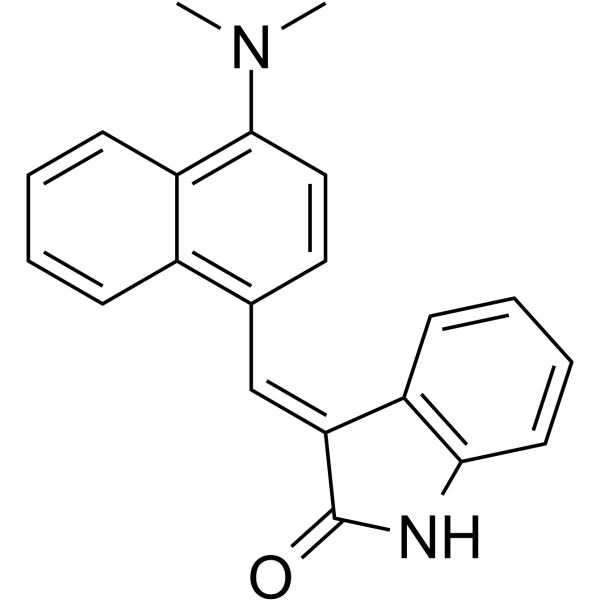
- HY-101042
-
|
Tyrphostin AG 494
|
EGFR
CDK
|
Cancer
|
|
AG-494 (Tyrphostin AG 494) is a potent and selective EGFR tyrosine kinase inhibitor (IC50=0.7 μM). AG-494 inhibits the autophosphorylation of EGFR, ErbB2, HER1-2 and PDGF-R with IC50s 1.1, 39, 45 and 6 μM, respectively. AG-494 blocks Cdk2 activation and inhibits EGF-dependent DNA synthesis .
|
-
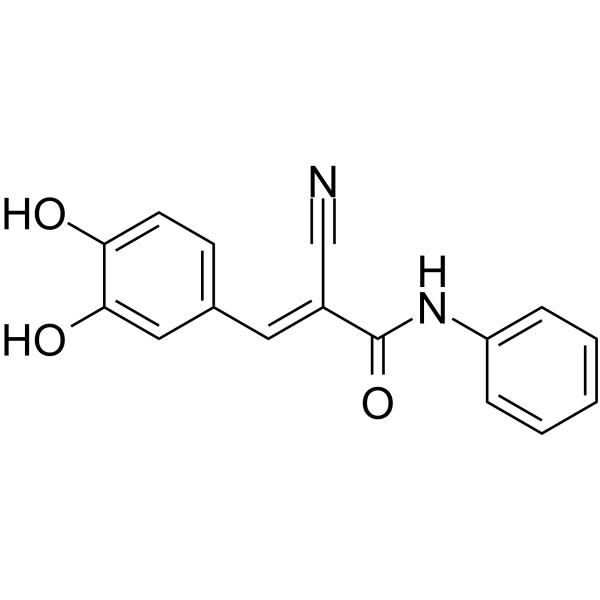
- HY-151285
-
|
|
Apoptosis
JAK
|
Inflammation/Immunology
Cancer
|
|
JAK-2-/3-IN-3 (compound ST4j) is a potent JAK2/3 inhibitor with IC50s of 13.00 and 14.86 nM for JAK2 and JAK3, respectively. JAK-2-/3-IN-3 inhibits autophosphorylation of JAK2 and induces apoptosis in a dose- and time-dependent manner. JAK-2-/3-IN-3 can be used in studies of lymph derived diseases and leukemia .
|
-
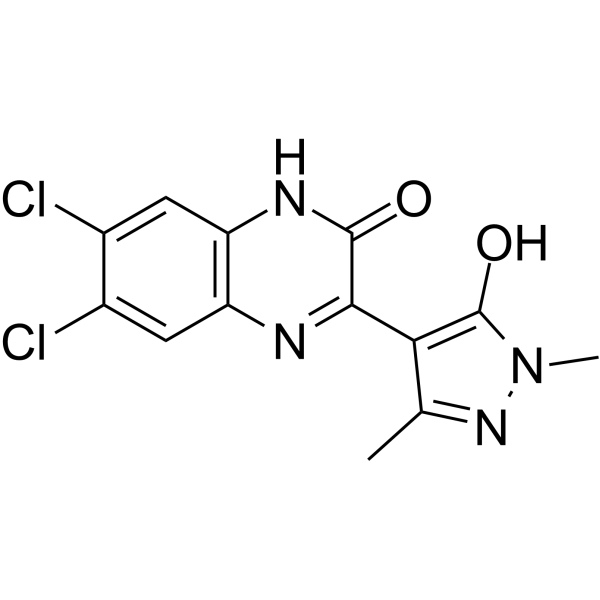
- HY-151441
-
|
|
LRRK2
|
Neurological Disease
|
|
LRRK2-IN-5 (compound 25) is a potent, orally active, selective leucine rich repeat protein kinase 2 gene (LRRK2) inhibitor with IC50 values of 1.2 and 16 μM for GS LRRK2 and WT LRRK2, respectively. LRRK2-IN-5 inhibits LRRK2 Ser1292 and Ser925 autophosphorylation. LRRK2-IN-5 can cross the blood-brain barrier .
|
-
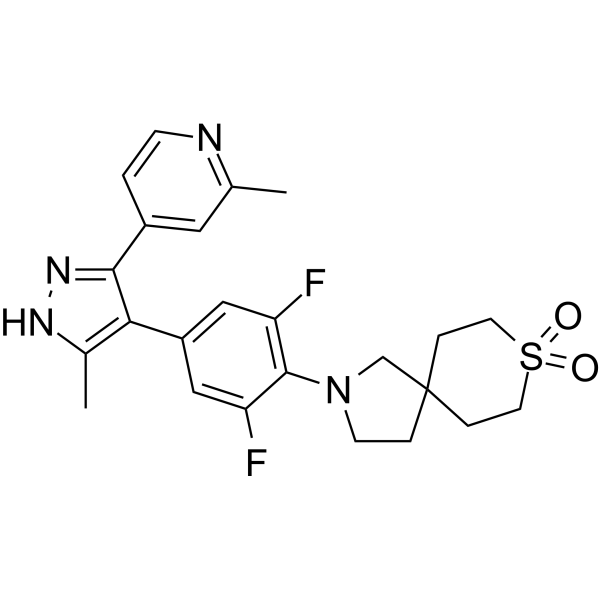
- HY-151444
-
|
|
LRRK2
|
Neurological Disease
|
|
LRRK2-IN-6 (compound 22) is a potent, orally active, selective leucine rich repeat protein kinase 2 gene (LRRK2) inhibitor with IC50 values of 4.6 and 49 μM for GS LRRK2 and WT LRRK2, respectively. LRRK2-IN-6 inhibits LRRK2 Ser1292 and Ser925 autophosphorylation. LRRK2-IN-6 can cross the blood-brain barrier .
|
-
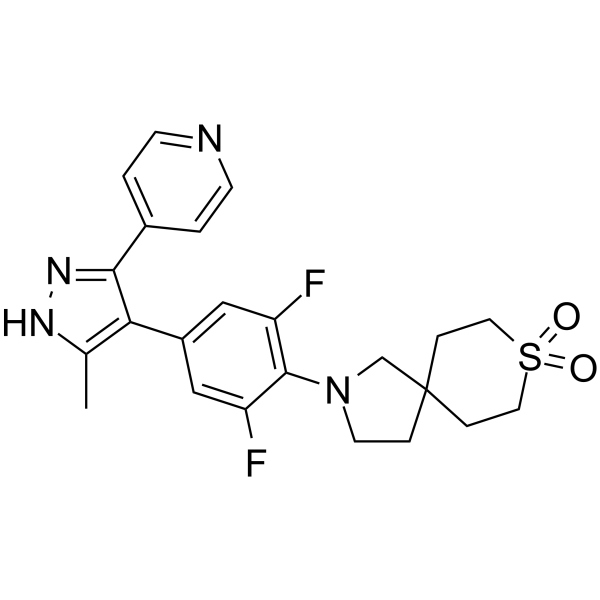
- HY-50895R
-
|
ZD1839 (Standard)
|
EGFR
Autophagy
Apoptosis
|
Cancer
|
|
Gefitinib (Standard) is the analytical standard of Gefitinib. This product is intended for research and analytical applications. Gefitinib (ZD1839) is a potent, selective and orally active EGFR tyrosine kinase inhibitor with an IC50 of 33 nM. Gefitinib selectively inhibits EGF-stimulated tumor cell growth (IC50 of 54 nM) and that blocks EGF-stimulated EGFR autophosphorylation in tumor cells. Gefitinib also induces autophagy and cell apoptosis, which can be used for cancer related research, such as Lung cancer and breast cancer .
|
-

- HY-13001
-
|
AC220
|
FLT3
Ligands for Target Protein for PROTAC
Apoptosis
Autophagy
|
Cancer
|
|
Quizartinib (AC220) is an orally active, highly selective and potent second-generation type II FLT3 tyrosine kinase inhibitor, with a Kd of 1.6 nM. Quizartinib inhibits wild-type FLT3 and FLT3-ITD autophosphorylation in MV4-11 cells with IC50s of 4.2 and 1.1 nM, respectively. Quizartinib can be linked to the VHL ligand via an optimized linker to form a PROTAC FLT3 degrader. Quizartinib induces apoptosis .
|
-
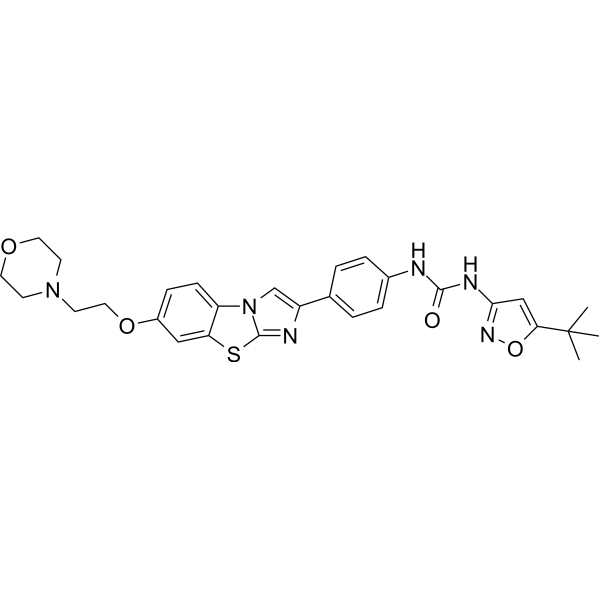
- HY-101544
-
|
|
FGFR
|
Cancer
|
|
ARQ 069, an analog of ARQ 523, inhibits FGFR in an enantiospecific manner. ARQ 069 targets the unphosphorylated, inactive forms of FGFR1/FGFR2 kinases (IC50s of 0.84 μM and 1.23 μM, respectively). ARQ 069 inhibits FGFR1/FGFR2 autophosphorylation (IC50s of 2.8 and 1.9 μM, respectively) through a mechanism in a non-ATP competitive dependent manner .
|
-
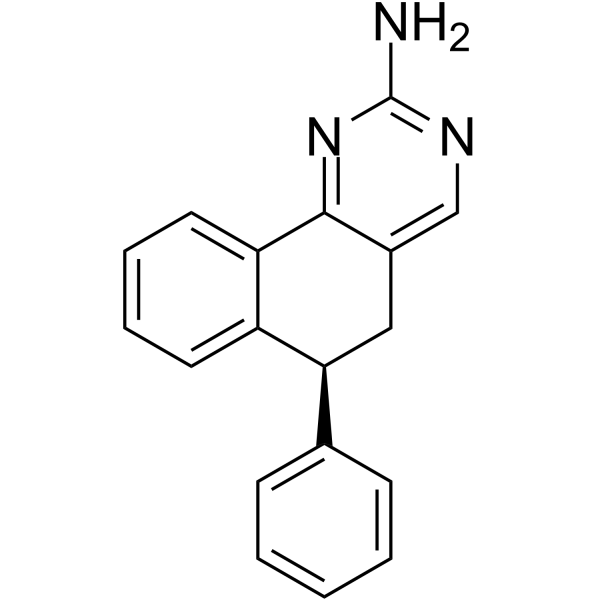
- HY-136735
-
|
|
IRE1
|
Neurological Disease
Cancer
|
|
IRE1α kinase-IN-1 is a highly selective IRE1α (ERN1) inhibitor, with an IC50 of 77 nM. IRE1α kinase-IN-1 displays 100-fold selectivity for IRE1α over the IRE1β isoform. IRE1α kinase-IN-1 inhibits ER stress-induced IRE1α oligomerization and autophosphorylation, and also inhibits IRE1α RNase activity (IC50=80 nM) .
|
-

- HY-118304
-
|
|
FLT3
Apoptosis
Caspase
|
Cancer
|
|
AKN-028, a novel tyrosine kinase (TK) inhibitor, is a potent, orally active FMS-like receptor tyrosine kinase 3 (FLT3) inhibitor with an IC50 value of 6 nM. AKN-028 inhibits FLT3 autophosphorylation. AKN-028 induces dose-dependent cytotoxic response (mean IC50=1 μM). AKN-028 induces apoptosisby activation of caspase 3. AKN-028 can be used in research of acute myeloid leukemia (AML) .
|
-
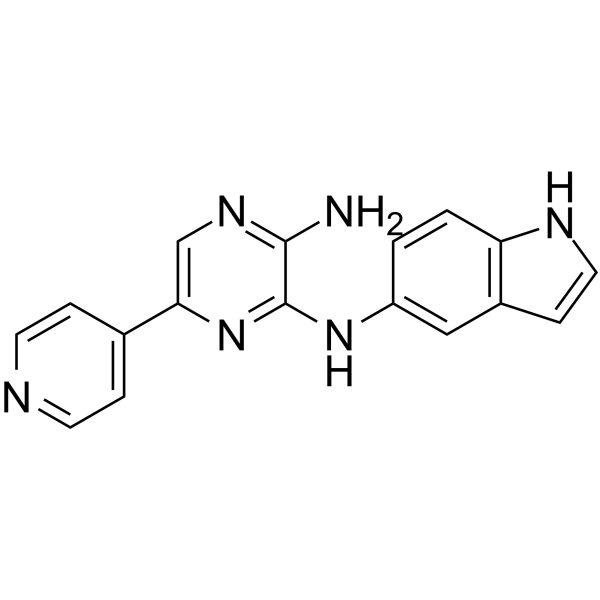
- HY-101450
-
|
|
|
|
|
PF-6274484 is a potent EGFR inhibitor with Kis of 0.14 nM and 0.18 nM for EGFR-L858R/T790M and WT EGFR, respectively. PF-6274484 inhibits EGFR-L858R/T790M autophosphorylation in H1975 tumor cells and EGFR WT in A549 tumor cells with IC50s of 6.6 and 5.8 nM, respectively .
|
-
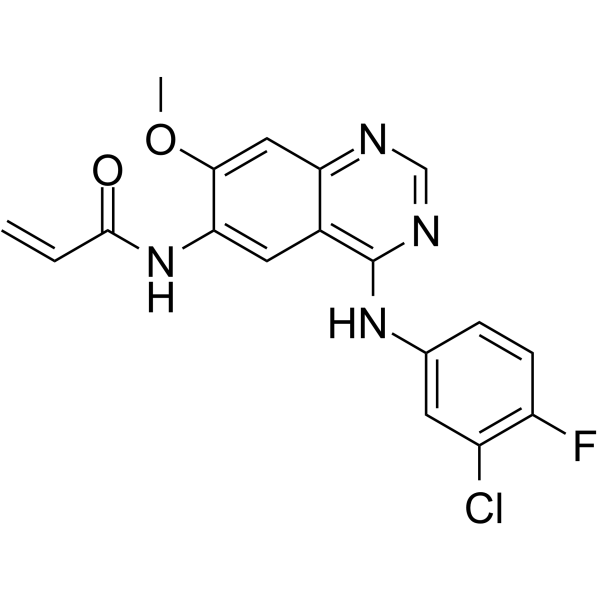
- HY-144437
-
|
|
TGF-β Receptor
|
Cancer
|
|
ALK5-IN-9 (Compound 8h) is a potent and orally active inhibitor of TGFβRI (ALK5). ALK5-IN-9 inhibits ALK5 autophosphorylation and NIH3T3 cell activity with IC50 values of 25 nM and 74.6 nM, respectively. ALK5-IN-9 also shows favorable pharmacokinetic profile and ameliorated hERG inhibition. ALK5-IN-9 has the potential for the research of cancer disease .
|
-
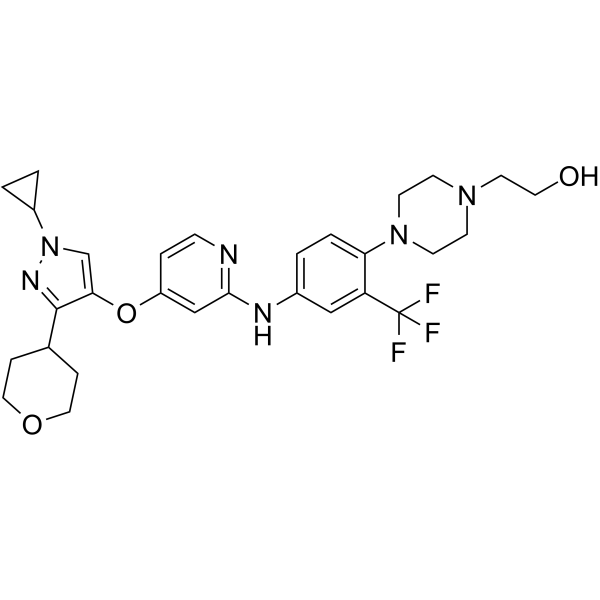
- HY-118304B
-
|
|
FLT3
Apoptosis
Caspase
|
Cancer
|
|
AKN-028 acetate, a novel tyrosine kinase (TK) inhibitor, is a potent, orally active FMS-like receptor tyrosine kinase 3 (FLT3) inhibitor with an IC50 value of 6 nM. AKN-028 acetate inhibits FLT3 autophosphorylation. AKN-028 acetate induces dose-dependent cytotoxic response (mean IC50=1 μM). AKN-028 acetate induces apoptosisby activation of caspase 3. AKN-028 acetate can be used in research of acute myeloid leukemia (AML).
|
-

- HY-P99284
-
|
MK-0646; h7C10
|
IGF-1R
Apoptosis
|
Cancer
|
|
Dalotuzumab (MK-0646) is a recombinant humanized monoclonal antibody (IgG1 type) targeting IGF-1R. Dalotuzumab acts by inhibiting IGF-1- and IGF-2-mediated tumor cell proliferation, IGF-1R autophosphorylation, and Akt phosphorylation. Dalotuzumab also induces apoptosis and cycle arrest. Dalotuzumab in combination with other anticancer agents such as statins can enhance the antitumor activity of Dalotuzumab in vitro and in vivo .
|
-

- HY-100434
-
|
|
|
|
|
PD-161570 is a potent and ATP-competitive human FGF-1 receptor inhibitor with an IC50 of 39.9 nM and a Ki of 42 nM. PD-161570 also inhibits the PDGFR, EGFR and c-Src tyrosine kinases with IC50 values of 310 nM, 240 nM, and 44 nM, respectively. PD-161570 inhibits PDGF-stimulated autophosphorylation and FGF-1 receptor phosphorylation with IC50s of 450 nM and 622 nM, respectively . PD-161570 is also a bone morphogenetic proteins (BMPs) and TGF-β signaling inhibitor .
|
-

- HY-112345
-
|
|
FGFR
PDGFR
EGFR
Src
|
Cancer
|
|
PD-089828 is an ATP competitive inhibitor of FGFR-1, PDGFR-β and EGFR (IC50s=0.15, 1.76, and 5.47 µM, respectively) and a noncompetitive inhibitor of c-Src tyrosine kinase (IC50=0.18 µM). PD-089828 also inhibits MAPK with an IC50 of 7.1 µM. PD-089828 inhibits PDGF-, EGF- and bFGF-mediated tyrosine kinase receptor autophosphorylation in vitro. PD-089828 has a long-lasting cellular activity .
|
-
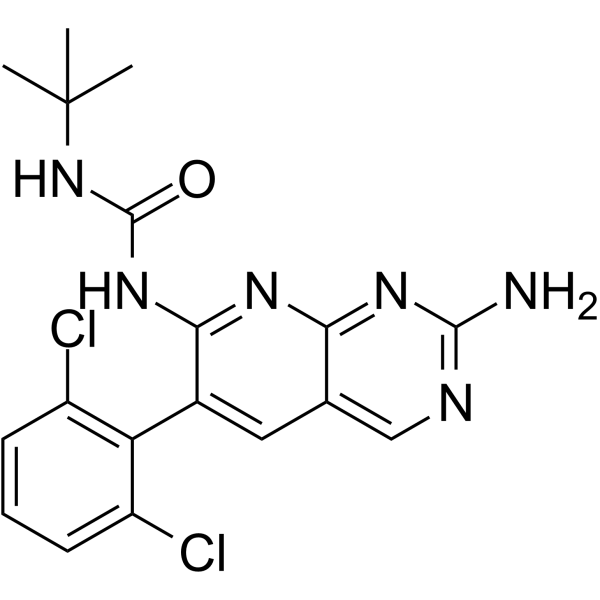
- HY-147414
-
|
PF-114
|
Bcr-Abl
|
Cancer
|
|
Vamotinib (PF-114) is a potent, selective and orally active tyrosine kinase inhibitor. Vamotinib inhibits the autophosphorylation of BCR/ABL and BCR/ABL-T315I. Vamotinib induces apoptosis. Vamotinib shows anti-proliferative and anti-tumor activity. Vamotinib has the potential for the research of resistant philadelphia chromosome-positive (Ph+) leukemia. Vamotinib inhibits ABL series kinases with IC50s of 0.49 nM (ABL), 0.78 nM (ABL T315I), 9.5 nM (ABL E255K), 2.0 nM (ABL F317I), 7.4 nM (ABL G250E), 1.0 nM (ABL H396P), 2.8 nM (ABL M351T), 12 nM (ABL Q252H), and 4.1 nM (ABL Y253F), respectively . Vamotinib is a click chemistry reagent, it contains an Alkyne group and can undergo copper-catalyzed azide-alkyne cycloaddition (CuAAc) with molecules containing Azide groups.
|
-

-
-
HY-L016
-
|
|
1055 compounds
|
|
Protein tyrosine kinases (PTKs) are key signaling molecules and important drug targets. Two classes of PTKs are present in cells: the transmembrane receptor PTKs (RTKs) and the nonreceptor PTKs. The RTK family includes the receptors for insulin and for many growth factors, such as EGFR, FGFR, PDGFR, VEGFR, and NGFR. RTKs are transmembrane glycoproteins that are activated by the binding of their ligands, and they transduce the extracellular signal to the cytoplasm by phosphorylating tyrosine residues on the receptors themselves (autophosphorylation) and on downstream signaling proteins. Their principal functions of PTKs involve the regulation of multicellular aspects of the organism. Cell to cell signals concerning growth, differentiation, adhesion, motility, and death are frequently transmitted through tyrosine kinases. In humans, tyrosine kinases have been demonstrated to play significant roles in the development of many disease states, including diabetes and cancers.
MCE designs a unique collection of 1055 compounds that act as a useful tool for PTKs-related drug screening and disease research.
|
| Cat. No. |
Product Name |
Target |
Research Area |
-
- HY-P3744
-
|
|
Peptides
|
Others
|
|
pp60v-src Autophosphorylation site is a synthetic peptide. pp60v-src Autophosphorylation site can be used for various biochemical studies .
|
-
- HY-P2548
-
|
|
EGFR
|
Others
|
|
pp60 (v-SRC) Autophosphorylation Site, Phosphorylated is the phosphorylated peptide of an EGFR substrate. pp60 (v-SRC) Autophosphorylation Site, Phosphorylated can be used for the screening of EGFR Kinase inhibitors via phosphorylated-substrate quantification .
|
-
- HY-P1799
-
|
|
Phosphatase
|
Others
|
|
[pTyr5] EGFR (988-993) is derived from the autophosphorylation site (Tyr992) of epidermal growth factor receptor (EGFR 988-993). [pTyr5] EGFR (988-993) is often complexed with the catalytically inactive protein-tyrosine phosphate 1B (PTP1B) .
|
-
- HY-P1799A
-
|
|
Phosphatase
|
Others
|
|
[pTyr5] EGFR (988-993) TFA is derived from the autophosphorylation site (Tyr992) of epidermal growth factor receptor (EGFR 988-993). [pTyr5] EGFR (988-993) TFA is often complexed with the catalytically inactive protein-tyrosine phosphate 1B (PTP1B) .
|
| Cat. No. |
Product Name |
Target |
Research Area |
-
- HY-P99284
-
|
MK-0646; h7C10
|
IGF-1R
Apoptosis
|
Cancer
|
|
Dalotuzumab (MK-0646) is a recombinant humanized monoclonal antibody (IgG1 type) targeting IGF-1R. Dalotuzumab acts by inhibiting IGF-1- and IGF-2-mediated tumor cell proliferation, IGF-1R autophosphorylation, and Akt phosphorylation. Dalotuzumab also induces apoptosis and cycle arrest. Dalotuzumab in combination with other anticancer agents such as statins can enhance the antitumor activity of Dalotuzumab in vitro and in vivo .
|
| Cat. No. |
Product Name |
Category |
Target |
Chemical Structure |
| Cat. No. |
Product Name |
Chemical Structure |
-
- HY-50895S1
-
|
|
|
Gefitinib-d6 is the deuterium labeled Gefitinib. Gefitinib (ZD1839) is a potent, selective and orally active EGFR tyrosine kinase inhibitor with an IC50 of 33 nM. Gefitinib selectively inhibits EGF-stimulated tumor cell growth (IC50 of 54 nM) and that blocks EGF-stimulated EGFR autophosphorylation in tumor cells. Gefitinib also induces autophagy. Gefitinib has antitumour activity[1][2].
|
-

-
- HY-50895S2
-
|
|
|
Gefitinib-d3 (ZD1839-d3) is the deuterium labeled Gefitinib. Gefitinib (ZD1839) is a potent, selective and orally active EGFR tyrosine kinase inhibitor with an IC50 of 33 nM. Gefitinib selectively inhibits EGF-stimulated tumor cell growth (IC50 of 54 nM) and that blocks EGF-stimulated EGFR autophosphorylation in tumor cells. Gefitinib also induces autophagy. Gefitinib has antitumour activity[1][2].
|
-

-
- HY-10255AS1
-
|
|
|
Sunitinib-d4 is the deuterium labeled Sunitinib. Sunitinib (SU 11248) is a multi-targeted receptor tyrosine kinase inhibitor with IC50s of 80 nM and 2 nM for VEGFR2 and PDGFRβ, respectively[1]. Sunitinib, an ATP-competitive inhibitor, effectively inhibits autophosphorylation of Ire1α by inhibiting autophosphorylation and consequent RNase activation[2].
|
-

-
- HY-149413
-
|
|
|
FHND5071 is a potent and selective RET kinase inhibitor, FHND5071 can exert antitumor effects by inhibiting RET autophosphorylation. FHND5071 can be used for tumor diseases research .
|
-

-
- HY-108263S
-
|
|
|
3-Hydroxy Midostaurin-d5 is a deuterium labeled 3-Hydroxy Midostaurin. 3-Hydroxy Midostaurin is a metabolite of PKC412, which effectively inhibits FMS-like tyrosine kinase-3 (FLT3) autophosphorylation with IC50s of approximately 132 nM and 9.8 μM in culture medium and plasma, respectively[1].
|
-

| Cat. No. |
Product Name |
|
Classification |
-
- HY-50896
-
|
CP-358774; NSC 718781; OSI-774
|
|
Alkynes
|
|
Erlotinib (CP-358774) is a directly acting EGFR tyrosine kinase inhibitor, with an IC50 of 2 nM for human EGFR. Erlotinib reduces EGFR autophosphorylation in intact tumor cells with an IC50 of 20 nM. Erlotinib is used for the treatment of non-small cell lung cancer . Erlotinib is a click chemistry reagent, itcontains an Alkyne group and can undergo copper-catalyzed azide-alkyne cycloaddition (CuAAc) with molecules containing Azide groups.
|
Your information is safe with us. * Required Fields.
Inquiry Information
- Product Name:
- Cat. No.:
- Quantity:
- MCE Japan Authorized Agent:





































![[pTyr5] EGFR (988-993)](http://file.medchemexpress.com/product_pic/hy-p1799.gif)




![[pTyr5] EGFR (988-993) (TFA)](http://file.medchemexpress.com/product_pic/hy-p1799a.gif)














































